Itinerary
The main island of Singapore is shaped like a flattened diamond, 42 km (26 miles) east to west and 23 km (14 miles) north to south. Near the northern peak is the causeway leading to West Malaysia—Kuala Lumpur is less than four hours away by car. It is at the southern foot where you will find most of the city-state’s action, with its gleaming office towers, working docks, and futuristic “supertrees,” which are solar-powered and serve as vertical gardens. Offshore are Sentosa and over 60 smaller islands, most uninhabited, that serve as bases for oil refining or as playgrounds and beach escapes from the city. To the east is Changi International Airport, connected to the city by metro, bus, and a tree-lined parkway. Of the island’s total land area, more than half is built up, with the balance made up of parkland, farmland, plantations, swamp areas, and rain forest. Well-paved roads connect all parts of the island, and Singapore city has an excellent, and constantly expanding, public transportation system. The heart of Singapore’s history and its modern wealth are in and around the Central Business District. The area includes the skyscrapers in the Central Business District, the 19th-century Raffles Hotel, the convention centers of Marina Square, on up to the top of Ft. Canning. Although most of old Singapore has been knocked down to make way for the modern city, most colonial landmarks have been preserved in the CBD, including early-19th-century buildings designed by the Irish architect George Coleman.
Day itinerary:
Advanced, airy and elevated, Singapore is a spectacular, futuristic vision of utopian city life. A healthy population of almost six million call it home, but this is a city designed with space to breathe, and gorgeous outdoor parks, massive indoor greenhouses and beautiful recreational spaces spread between the City of Gardens’ skyscrapers and soaring structures. Once a quiet fishing village, now a glistening island city-state and an international beacon of science, education and technology. Singapore is almost intimidatingly clean – and the hyper-efficient public transport system whips residents and visitors across the city’s neighbourhoods in a heartbeat. Glorious fountains and audacious skyscrapers loom up – nodding to traditional feng shui beliefs – and putting on dazzling illuminated displays after dark. The lush green botanical gardens are a spectacular UNESCO World Heritage Site, covering 52 hectares and decorated with impressive colourful orchids. Or breathe in more of the freshest air by heading up to wander the canopy strung bridges of MacRitchie Reservoir Park. Head for the iconic Marina Bay – a landmark of the city crowned by three interconnected towers, which watch out over island sprinkled waters. Jaunt between Little India and the atmospheric Chinatown in minutes, where beautiful temples – like the Chinese Thian Hock Keng Temple and Hindu Sri Mariamman Temple add rich cultural intrigue. Singapore’s cuisine is a mouthwatering fusion of its Indian, Chinese, Indonesian, and Malay influences, taking and enhancing the best of each. Enjoy dishes in towering restaurants, or toast the glowing skyline with the city’s eponymous gin-soaked cocktail – a Singapore Sling.
There are two Bangkoks, the ancient soul of Thailand with its long and fascinating history and the frantic, modern metropolis that embraces the latest trends both Eastern and Western. The two blend together remarkably well—even the most jarring juxtapositions of old and new somehow make sense. Bangkok is not only the biggest city in Thailand, but also the most mesmerizing, with some of the country’s most beautiful temples and shrines. The city’s energy is palpable, especially at night, when traffic opens up a bit, its famous markets get going, and everything seems lit up—from its proudest monuments to its seediest streets. When Ayutthaya was besieged and pillaged by the Burmese in 1766, Thonburi became Thailand’s capital. The Thais call Bangkok Krung Thep (City of Angels), and in 1782 King Rama I moved his capital here, just across the Chao Praya River. Laem Chabang is approximately 130 km (81 mi) from Bangkok.
Day itinerary:
A voyage of flavour and an all-out sensory assault Bangkok is one of the world’s most fascinating cities and a place to plunge right in at the deep end. Immense tradition and relentless modernity combines and it’s these contrasts and collisions that make Bangkok the remarkable all-encompassing experience it is. Ornate towers and places of worship blend in alongside cathedral-like shopping malls and skyscrapers while the streets hum with bartering from the markets that spill out wherever you walk. Part of Bangkok’s allure is that Iife is well and truly played out on its streets. Stalls of flowers spices and silk fabrics fill bustling alleyways with colour and exotic fragrances. You can find fine dining hidden away here – including Michellin-starred restaurants – but the real Bangkok is the feast of flavours on street level – where authentic Pad Thai is cooked up alongside spicy papaya salad. To truly know Bangkok you must sail the waters of the Chao Phraya river which provides a cooling thoroughfare through the city. You’ll sail through Bangkok’s soul with glorious temples leaning up against the river’s banks filled with intricately decorated Buddha statues. One of the country’s most sacred sites – the Temple of the Emerald Buddha – rises in a river bend while the beautiful Grand Palace and the skyscraper-like tower of the colourful Wat Arun temple also watch out over the water.
There are two Bangkoks, the ancient soul of Thailand with its long and fascinating history and the frantic, modern metropolis that embraces the latest trends both Eastern and Western. The two blend together remarkably well—even the most jarring juxtapositions of old and new somehow make sense. Bangkok is not only the biggest city in Thailand, but also the most mesmerizing, with some of the country’s most beautiful temples and shrines. The city’s energy is palpable, especially at night, when traffic opens up a bit, its famous markets get going, and everything seems lit up—from its proudest monuments to its seediest streets. When Ayutthaya was besieged and pillaged by the Burmese in 1766, Thonburi became Thailand’s capital. The Thais call Bangkok Krung Thep (City of Angels), and in 1782 King Rama I moved his capital here, just across the Chao Praya River. Laem Chabang is approximately 130 km (81 mi) from Bangkok.
Day itinerary:
A voyage of flavour and an all-out sensory assault Bangkok is one of the world’s most fascinating cities and a place to plunge right in at the deep end. Immense tradition and relentless modernity combines and it’s these contrasts and collisions that make Bangkok the remarkable all-encompassing experience it is. Ornate towers and places of worship blend in alongside cathedral-like shopping malls and skyscrapers while the streets hum with bartering from the markets that spill out wherever you walk. Part of Bangkok’s allure is that Iife is well and truly played out on its streets. Stalls of flowers spices and silk fabrics fill bustling alleyways with colour and exotic fragrances. You can find fine dining hidden away here – including Michellin-starred restaurants – but the real Bangkok is the feast of flavours on street level – where authentic Pad Thai is cooked up alongside spicy papaya salad. To truly know Bangkok you must sail the waters of the Chao Phraya river which provides a cooling thoroughfare through the city. You’ll sail through Bangkok’s soul with glorious temples leaning up against the river’s banks filled with intricately decorated Buddha statues. One of the country’s most sacred sites – the Temple of the Emerald Buddha – rises in a river bend while the beautiful Grand Palace and the skyscraper-like tower of the colourful Wat Arun temple also watch out over the water.
Romantically referred to by the French as the Pearl of the Orient, Ho Chi Minh City today is a super-charged city of sensory overload. Motorbikes zoom day and night along the wide boulevards, through the narrow back alleys and past vendors pushing handcarts hawking goods of all descriptions. Still called Saigon by most residents, this is Vietnam’s largest city and the engine driving the country’s current economic resurgence, but despite its frenetic pace, it’s a friendlier place than Hanoi and locals will tell you the food—simple, tasty, and incorporating many fresh herbs—is infinitely better than in the capital.This is a city full of surprises. The madness of the city’s traffic—witness the oddball things that are transported on the back of motorcycles—is countered by tranquil pagodas, peaceful parks, quirky coffee shops, and whole neighborhoods hidden down tiny alleyways, although some of these quiet spots can be difficult to track down. Life in Ho Chi Minh City is lived in public: on the back of motorcycles, on the sidewalks, and in the parks. Even when its residents are at home, they’re still on display. With many living rooms opening onto the street, grandmothers napping, babies being rocked, and food being prepared, are all in full view of passersby.Icons of the past endure in the midst of the city’s headlong rush into capitalism. The Hotel Continental, immortalized in Graham Greene’s The Quiet American, continues to stand on the corner of old Indochina’s most famous thoroughfare, the rue Catinat, known to American G.I.s during the Vietnam War as Tu Do (Freedom) Street and renamed Dong Khoi (Uprising) Street by the Communists. The city still has its ornate opera house and its old French city hall, the Hôtel de Ville. The broad colonial boulevards leading to the Saigon River and the gracious stucco villas are other remnants of the French colonial presence. Grisly reminders of the more recent past can be seen at the city’s war-related museums. Residents, however, prefer to look forward rather than back and are often perplexed by tourists’ fascination with a war that ended 40 years ago.The Chinese influence on the country is still very much in evidence in the Cholon district, the city’s Chinatown, but the modern office towers and international hotels that mark the skyline symbolize Vietnam’s fixation on the future.
Day itinerary:
A chaotic enchanting swirl of sensory stimulation – Ho Chi Minh City is a place of incense-infused temples colonial architecture warm people and delicious street food. Formerly known as Saigon the city was affectionately-labelled the Pearl of the Orient by the French. Afternoons here drift by lazily on the gentle chaos of the River Saigon as taxi boats and motor canoes flit up and down and parks fill out with locals playing jianzi kicking shuttlecocks back and forth. Just across the road you’ll also find the celebrated Ho Chi Minh Post office which was erroneously credited as a Gustav Eifel creation. In reality the architect was another Frenchman Alfred Foulhoux. Taste the street food to get under Ho Chi Minh City’s skin with humble restaurants serving up rich flavours – from the Vietnamese take on the baguette a banh mi sandwich – to the local staple of pho a delicious noodle soup. The Tortoise pagoda is a tranquil escape and a serene place of worship for Vietnamese who practice Buddhism and Taoism while the Vietnamese medical museum has a fascinating collection of remedies and potions – some dating back to Stone Age. Journey out to learn more of the Vietnam War at the Remnants Museum and Cu Chi tunnels. Offering a vivid glimpse of conditions and the ingenuity and resilience of the soldiers you’ll learn of the guerrilla war campaign raged from within this claustrophobic 70-mile network of war tunnels.
Romantically referred to by the French as the Pearl of the Orient, Ho Chi Minh City today is a super-charged city of sensory overload. Motorbikes zoom day and night along the wide boulevards, through the narrow back alleys and past vendors pushing handcarts hawking goods of all descriptions. Still called Saigon by most residents, this is Vietnam’s largest city and the engine driving the country’s current economic resurgence, but despite its frenetic pace, it’s a friendlier place than Hanoi and locals will tell you the food—simple, tasty, and incorporating many fresh herbs—is infinitely better than in the capital.This is a city full of surprises. The madness of the city’s traffic—witness the oddball things that are transported on the back of motorcycles—is countered by tranquil pagodas, peaceful parks, quirky coffee shops, and whole neighborhoods hidden down tiny alleyways, although some of these quiet spots can be difficult to track down. Life in Ho Chi Minh City is lived in public: on the back of motorcycles, on the sidewalks, and in the parks. Even when its residents are at home, they’re still on display. With many living rooms opening onto the street, grandmothers napping, babies being rocked, and food being prepared, are all in full view of passersby.Icons of the past endure in the midst of the city’s headlong rush into capitalism. The Hotel Continental, immortalized in Graham Greene’s The Quiet American, continues to stand on the corner of old Indochina’s most famous thoroughfare, the rue Catinat, known to American G.I.s during the Vietnam War as Tu Do (Freedom) Street and renamed Dong Khoi (Uprising) Street by the Communists. The city still has its ornate opera house and its old French city hall, the Hôtel de Ville. The broad colonial boulevards leading to the Saigon River and the gracious stucco villas are other remnants of the French colonial presence. Grisly reminders of the more recent past can be seen at the city’s war-related museums. Residents, however, prefer to look forward rather than back and are often perplexed by tourists’ fascination with a war that ended 40 years ago.The Chinese influence on the country is still very much in evidence in the Cholon district, the city’s Chinatown, but the modern office towers and international hotels that mark the skyline symbolize Vietnam’s fixation on the future.
Day itinerary:
A chaotic enchanting swirl of sensory stimulation – Ho Chi Minh City is a place of incense-infused temples colonial architecture warm people and delicious street food. Formerly known as Saigon the city was affectionately-labelled the Pearl of the Orient by the French. Afternoons here drift by lazily on the gentle chaos of the River Saigon as taxi boats and motor canoes flit up and down and parks fill out with locals playing jianzi kicking shuttlecocks back and forth. Just across the road you’ll also find the celebrated Ho Chi Minh Post office which was erroneously credited as a Gustav Eifel creation. In reality the architect was another Frenchman Alfred Foulhoux. Taste the street food to get under Ho Chi Minh City’s skin with humble restaurants serving up rich flavours – from the Vietnamese take on the baguette a banh mi sandwich – to the local staple of pho a delicious noodle soup. The Tortoise pagoda is a tranquil escape and a serene place of worship for Vietnamese who practice Buddhism and Taoism while the Vietnamese medical museum has a fascinating collection of remedies and potions – some dating back to Stone Age. Journey out to learn more of the Vietnam War at the Remnants Museum and Cu Chi tunnels. Offering a vivid glimpse of conditions and the ingenuity and resilience of the soldiers you’ll learn of the guerrilla war campaign raged from within this claustrophobic 70-mile network of war tunnels.
Romantically referred to by the French as the Pearl of the Orient, Ho Chi Minh City today is a super-charged city of sensory overload. Motorbikes zoom day and night along the wide boulevards, through the narrow back alleys and past vendors pushing handcarts hawking goods of all descriptions. Still called Saigon by most residents, this is Vietnam’s largest city and the engine driving the country’s current economic resurgence, but despite its frenetic pace, it’s a friendlier place than Hanoi and locals will tell you the food—simple, tasty, and incorporating many fresh herbs—is infinitely better than in the capital.This is a city full of surprises. The madness of the city’s traffic—witness the oddball things that are transported on the back of motorcycles—is countered by tranquil pagodas, peaceful parks, quirky coffee shops, and whole neighborhoods hidden down tiny alleyways, although some of these quiet spots can be difficult to track down. Life in Ho Chi Minh City is lived in public: on the back of motorcycles, on the sidewalks, and in the parks. Even when its residents are at home, they’re still on display. With many living rooms opening onto the street, grandmothers napping, babies being rocked, and food being prepared, are all in full view of passersby.Icons of the past endure in the midst of the city’s headlong rush into capitalism. The Hotel Continental, immortalized in Graham Greene’s The Quiet American, continues to stand on the corner of old Indochina’s most famous thoroughfare, the rue Catinat, known to American G.I.s during the Vietnam War as Tu Do (Freedom) Street and renamed Dong Khoi (Uprising) Street by the Communists. The city still has its ornate opera house and its old French city hall, the Hôtel de Ville. The broad colonial boulevards leading to the Saigon River and the gracious stucco villas are other remnants of the French colonial presence. Grisly reminders of the more recent past can be seen at the city’s war-related museums. Residents, however, prefer to look forward rather than back and are often perplexed by tourists’ fascination with a war that ended 40 years ago.The Chinese influence on the country is still very much in evidence in the Cholon district, the city’s Chinatown, but the modern office towers and international hotels that mark the skyline symbolize Vietnam’s fixation on the future.
Day itinerary:
A chaotic enchanting swirl of sensory stimulation – Ho Chi Minh City is a place of incense-infused temples colonial architecture warm people and delicious street food. Formerly known as Saigon the city was affectionately-labelled the Pearl of the Orient by the French. Afternoons here drift by lazily on the gentle chaos of the River Saigon as taxi boats and motor canoes flit up and down and parks fill out with locals playing jianzi kicking shuttlecocks back and forth. Just across the road you’ll also find the celebrated Ho Chi Minh Post office which was erroneously credited as a Gustav Eifel creation. In reality the architect was another Frenchman Alfred Foulhoux. Taste the street food to get under Ho Chi Minh City’s skin with humble restaurants serving up rich flavours – from the Vietnamese take on the baguette a banh mi sandwich – to the local staple of pho a delicious noodle soup. The Tortoise pagoda is a tranquil escape and a serene place of worship for Vietnamese who practice Buddhism and Taoism while the Vietnamese medical museum has a fascinating collection of remedies and potions – some dating back to Stone Age. Journey out to learn more of the Vietnam War at the Remnants Museum and Cu Chi tunnels. Offering a vivid glimpse of conditions and the ingenuity and resilience of the soldiers you’ll learn of the guerrilla war campaign raged from within this claustrophobic 70-mile network of war tunnels.
Da Nang is the third largest city in Vietnam with the land area of 1283 square kilometre and the population of approximately 1million people. Da Nang is growing into one of the most organized urban area, with attractive beach front villas on the one side and Han River flowing on the other. Of the few attractions that belong to the city, Museum of Cham stands out with its rich collection of Cham artefacts. For those who crave for more outdoors activities, My Khe beach is a good place to spend time, either by yourself or with your loved ones. Da Nang is in close proximity to Hue- 3 hours North and Hoi An- 30 minutes south, which makes it a perfect stop point for those who need a break from touristy areas. Hue was once the Royal Capital of Viet Nam. The city represents the outstanding demonstration of the power of the vanished Vietnamese feudal empire, including a complex of monuments, tombs and pagodas that attract tourists coming from all over the world. Hoi An has to this days well preserved its most sacred treasure, the centuries-old architecture. The town used to harbour foreign traders back in the 17-18th, and once is an important heavily-frequented trading port in Southeast Asia.
Day itinerary:
Halfway between Ho Chi Minh City and Hoi An, Da Nang often gets overlooked on the traveller trail. However, as the third largest city in Vietnam (with a population of 1 million), Da Nang packs a punch that other puts other Vietnamese cities in the shade. Naturally, Da Nang is a savvy choice. The beaches are simply stunning – white sand that runs on for miles, lapped by sapphire seas and punctuated by tall coconut trees. The mountains are stunning – vast swathes of emerald green poking out of the top of the few skyscrapers the city has. And the temples are vast and plentiful. From Lady Buddha – an 18th century shrine and statue that guards over the fishermen – to the Marble Mountains, Da Nang is a sublime mixture of secret lagoons, spiritual sites and Vietnamese energy. The aforementioned Marble Mountains are undeniably the city’s main attraction, although the Golden Hands Bridge (40 kilometres from the city centre) is fast overtaking the Mountains for top spot. Both are sublime in their beauty – one a spiritual pilgrimage site sculpted by (and named after) the elements, the other, a man-made structure of two giant concrete hands that stretch towards the sky. Add to that the busy markets selling everything from Vietnamese silk to street food and the My Son temple ruins (Vietnam’s answer to Angkor Wat) and you have a destination that offers travellers far more than tourist trinkets. If you are looking for a Vietnamese city that offers both connection and authenticity, you have found it in Da Nang.
A visit to the north is not complete without a trip to Halong Bay, where placid waters give way to more than 3,000 limestone karsts and wind-sculpted limestone formations that jut from foggy lagoons. Dotting the bay are tiny islands bordered by white sandy coves and hidden caves, adding to the majestic landscape of this UNESCO World Heritage Site. Adding to this naturalist’s dream is the biodiversity of islets, grottos, and Cat Ba Island National Park. The bay, however, shows tourism’s impact: the clearing of mangrove forests to make way for jetties and piers, marine life threatened by game fishing, and garbage from passenger boats and fishing villages washed up on the shores.Beyond its geological uniqueness are activities like hiking, kayaking, rock climbing, or exploring one of the many floating villages where fishermen bring in their daily catch. The downside to all this allure is the large number of unlicensed boats it draws to the bay each day.Boat trips out onto the bay are the main tourism stock in trade farther north, but a more multifaceted side of the area can be experienced at Cat Ba Island. The largest island in Halong Bay, Cat Ba is very much its own entity. Its national park offers incredible biodiversity, with more than a thousand species of plants having been recorded here. Animal life is slightly thinner on the ground, but alert visitors may spy inhabitants such as the endangered golden-headed langur, wild boar, deer, civets, and several species of squirrel. Trekking through the wilderness is a highlight with a number of fascinating trails to follow.Cat Ba Island has also become a firm favorite with the adventure sports set. Indeed, along with Railay Beach in Thailand, it is recognized as one of the top spots in the region for rock climbing. Other outdoor pursuits include sailing and kayaking around the karsts. Although Halong Bay has arguably been tainted by over-exposure, Bai Tu Long Bay farther east toward China, retains all the majesty of Vietnam’s premier bucket-list natural attraction but sees a fraction of the traffic of its immediate neighbor to the west. Here, visitors will find islands of substantial size with deserted beaches and untamed jungle. Halong Bay’s 3,000 islands of dolomite and limestone cover a 1,500-square-km (580-square-mile) area, extending across the Gulf of Tonkin nearly to the Chinese border. According to legend, this breathtaking land- and seascape was formed by a giant dragon that came barreling out of the mountains toward the ocean—hence the name (Halong translates into “descent of the dragon”). Geologists are more likely to attribute the formations to sedimentary limestone that formed here between 300 and 500 million years ago, in the Paleozoic Era. Over millions of years water receded and exposed the limestone to wind, rain, and tidal erosion.Today the limestone formations are exposed to hordes of tourists—but don’t let that discourage you. Hundreds of fishing trawlers and tour boats share space on these crystal waters, yet there seems to be room for everyone. Most people use the main population center, Halong City, as a base from which to venture into the bay. Although it’s now officially one municipality, Halong City was, until 1996, two separate towns: Bai Chay is now Halong City West, where Halong Road winds its way around the coast and past the lifeless central beach; Hon Gai is the grimier Halong City East, where a coal transportation depot dominates the center of town and covers nearby roads and buildings with a sooty film. Locals still refer to the towns by their old names, but they are now inexorably lassoed together by a bridge. Boat trips through Halong Bay are the main attraction. Little of the majesty of this region can be found in the city, so head out onto the water and start exploring. Countless 10- and 30-foot fishing boats have been converted into Halong Bay’s formidable tourist-boat fleet. Hotels or travel agencies in Halong City or Hanoi can arrange boat trips for you (often they are part of organized tours from Hanoi). It is still possible to go down to the wharf and bargain yourself onto a boat for the day, but you are likely to be charged (sometimes significantly) more than you would pay for a prebooked tour, so this is not advised. Self-sufficient travelers have fallen victim to the old bait-and-switch: they’ve arranged a next-day boat tour with local fishermen, only to be told in no uncertain terms the following morning that they could not board their chosen boat, but they could take a different one for quite a bit more money. You may have no choice in the end. Usually travel agencies, however, have their tried-and-true favorites.
Day itinerary:
A visit to the north is not complete without a trip to Halong Bay, where placid waters give way to more than 3,000 limestone karsts and wind-sculpted limestone formations that jut from foggy lagoons. Dotting the bay are tiny islands bordered by white sandy coves and hidden caves, adding to the majestic landscape of this UNESCO World Heritage Site. Adding to this naturalist’s dream is the biodiversity of islets, grottos, and Cat Ba Island National Park. The bay, however, shows tourism’s impact: the clearing of mangrove forests to make way for jetties and piers, marine life threatened by game fishing, and garbage from passenger boats and fishing villages washed up on the shores.Beyond its geological uniqueness are activities like hiking, kayaking, rock climbing, or exploring one of the many floating villages where fishermen bring in their daily catch. The downside to all this allure is the large number of unlicensed boats it draws to the bay each day.Boat trips out onto the bay are the main tourism stock in trade farther north, but a more multifaceted side of the area can be experienced at Cat Ba Island. The largest island in Halong Bay, Cat Ba is very much its own entity. Its national park offers incredible biodiversity, with more than a thousand species of plants having been recorded here. Animal life is slightly thinner on the ground, but alert visitors may spy inhabitants such as the endangered golden-headed langur, wild boar, deer, civets, and several species of squirrel. Trekking through the wilderness is a highlight with a number of fascinating trails to follow.Cat Ba Island has also become a firm favorite with the adventure sports set. Indeed, along with Railay Beach in Thailand, it is recognized as one of the top spots in the region for rock climbing. Other outdoor pursuits include sailing and kayaking around the karsts. Although Halong Bay has arguably been tainted by over-exposure, Bai Tu Long Bay farther east toward China, retains all the majesty of Vietnam’s premier bucket-list natural attraction but sees a fraction of the traffic of its immediate neighbor to the west. Here, visitors will find islands of substantial size with deserted beaches and untamed jungle. Halong Bay’s 3,000 islands of dolomite and limestone cover a 1,500-square-km (580-square-mile) area, extending across the Gulf of Tonkin nearly to the Chinese border. According to legend, this breathtaking land- and seascape was formed by a giant dragon that came barreling out of the mountains toward the ocean—hence the name (Halong translates into “descent of the dragon”). Geologists are more likely to attribute the formations to sedimentary limestone that formed here between 300 and 500 million years ago, in the Paleozoic Era. Over millions of years water receded and exposed the limestone to wind, rain, and tidal erosion.Today the limestone formations are exposed to hordes of tourists—but don’t let that discourage you. Hundreds of fishing trawlers and tour boats share space on these crystal waters, yet there seems to be room for everyone. Most people use the main population center, Halong City, as a base from which to venture into the bay. Although it’s now officially one municipality, Halong City was, until 1996, two separate towns: Bai Chay is now Halong City West, where Halong Road winds its way around the coast and past the lifeless central beach; Hon Gai is the grimier Halong City East, where a coal transportation depot dominates the center of town and covers nearby roads and buildings with a sooty film. Locals still refer to the towns by their old names, but they are now inexorably lassoed together by a bridge. Boat trips through Halong Bay are the main attraction. Little of the majesty of this region can be found in the city, so head out onto the water and start exploring. Countless 10- and 30-foot fishing boats have been converted into Halong Bay’s formidable tourist-boat fleet. Hotels or travel agencies in Halong City or Hanoi can arrange boat trips for you (often they are part of organized tours from Hanoi). It is still possible to go down to the wharf and bargain yourself onto a boat for the day, but you are likely to be charged (sometimes significantly) more than you would pay for a prebooked tour, so this is not advised. Self-sufficient travelers have fallen victim to the old bait-and-switch: they’ve arranged a next-day boat tour with local fishermen, only to be told in no uncertain terms the following morning that they could not board their chosen boat, but they could take a different one for quite a bit more money. You may have no choice in the end. Usually travel agencies, however, have their tried-and-true favorites.
The Hong Kong Island skyline, with its ever-growing number of skyscrapers, speaks to ambition and money. Paris, London, even New York were centuries in the making, while Hong Kong’s towers, bright lights, and glitzy shopping emporia weren’t yet part of the urban scene when many of the young investment bankers who fuel one of the world’s leading financial centers were born. Commerce is concentrated in the glittering high-rises of Central, tucked between Victoria Harbor and forested peaks on Hong Kong Island’s north shore. While it’s easy to think all the bright lights are the sum of today’s Hong Kong, you need only walk or board a tram for the short jaunt west into Western to discover a side of Hong Kong that is more traditionally Chinese but no less high-energy. You’ll discover the real Hong Kong to the east of Central, too, in Wan Chai, Causeway Bay, and beyond. Amid the residential towers are restaurants, shopping malls, bars, convention centers, a nice smattering of museums, and—depending on fate and the horse you wager on—one of Hong Kong’s luckiest or unluckiest spots, the Happy Valley Racecourse. Kowloon sprawls across a generous swath of the Chinese mainland across Victoria Harbour from Central. Tsim Sha Tsui, at the tip of Kowloon peninsula, is packed with glitzy shops, first-rate museums, and eye-popping views of the skyline across the water. Just to the north are the teeming market streets of Mong Kok and in the dense residential neighborhoods beyond, two of Hong Kong’s most enchanting spiritual sights, Wong Tai Sin Temple and Chi Lin Nunnery. As you navigate this huge metropolis (easy to do on the excellent transportation network), keep in mind that streets are usually numbered odd on one side, even on the other. There’s no baseline for street numbers and no block-based numbering system, but street signs indicate building numbers for any given block.
Day itinerary:
A spectacular, serrated skyline of soaring towers and neon lights, Hong Kong is a vibrant, immersive metropolis and cultural hub. Dramatic harbour-front light shows transform the waterfront’s gleaming buildings into a colourful canvas – best seen from the Star Ferry, when the Symphony of Lights blares into life each evening. A city where future and tradition collides – perhaps best illustrated by the skyscrapers that feature gaping holes, designed to allow spirit dragons to soar from the hills to the waterfront unimpeded. Wander flowing shopping streets, wade through sprawling markets and soak up the neon glory of this one-of-a-kind city – which continues to reach for the sky. Hong Kong’s dense jumble of activity is one of its main appeals, but once you’ve felt the thrill of rising to towering observation decks, to see the soaring city from above, it’s surprisingly easy to find peace among Hong Kong’s intense urban wonders. Victoria Peak is the highest point and it offers staggering views down over the city and harbour. The Peak Tram funicular can ferry you to the top, to the vantage point which was historically adored by the rich for the cooler air found here, away from the busy bustle of the city streets. Many elaborate temples add a tranquil element to Hong Kong’s whirr, and Tin Hau temple has a surprisingly urban location, considering its dedication to the Goddess of the Sea. It did once occupy the shorefront, but the city’s growth saw land reclaimed from the sea around it, leaving the temple marooned inland. Having been leased to the British for 99 years, milky tea is a revered tradition here – enjoy your cup with a serving of local dim sum.While it’s easy to think all the bright lights are the sum of today’s Hong Kong, you need only walk or board a tram for the short jaunt west into Western to discover a side of Hong Kong that is more traditionally Chinese but no less high-energy. You’ll discover the real Hong Kong to the east of Central, too, in Wan Chai, Causeway Bay, and beyond. Amid the residential towers are restaurants, shopping malls, bars, convention centers, a nice smattering of museums, and—depending on fate and the horse you wager on—one of Hong Kong’s luckiest or unluckiest spots, the Happy Valley Racecourse. Kowloon sprawls across a generous swath of the Chinese mainland across Victoria Harbour from Central. Tsim Sha Tsui, at the tip of Kowloon peninsula, is packed with glitzy shops, first-rate museums, and eye-popping views of the skyline across the water. Just to the north are the teeming market streets of Mong Kok and in the dense residential neighborhoods beyond, two of Hong Kong’s most enchanting spiritual sights, Wong Tai Sin Temple and Chi Lin Nunnery. As you navigate this huge metropolis (easy to do on the excellent transportation network), keep in mind that streets are usually numbered odd on one side, even on the other. There’s no baseline for street numbers and no block-based numbering system, but street signs indicate building numbers for any given block.
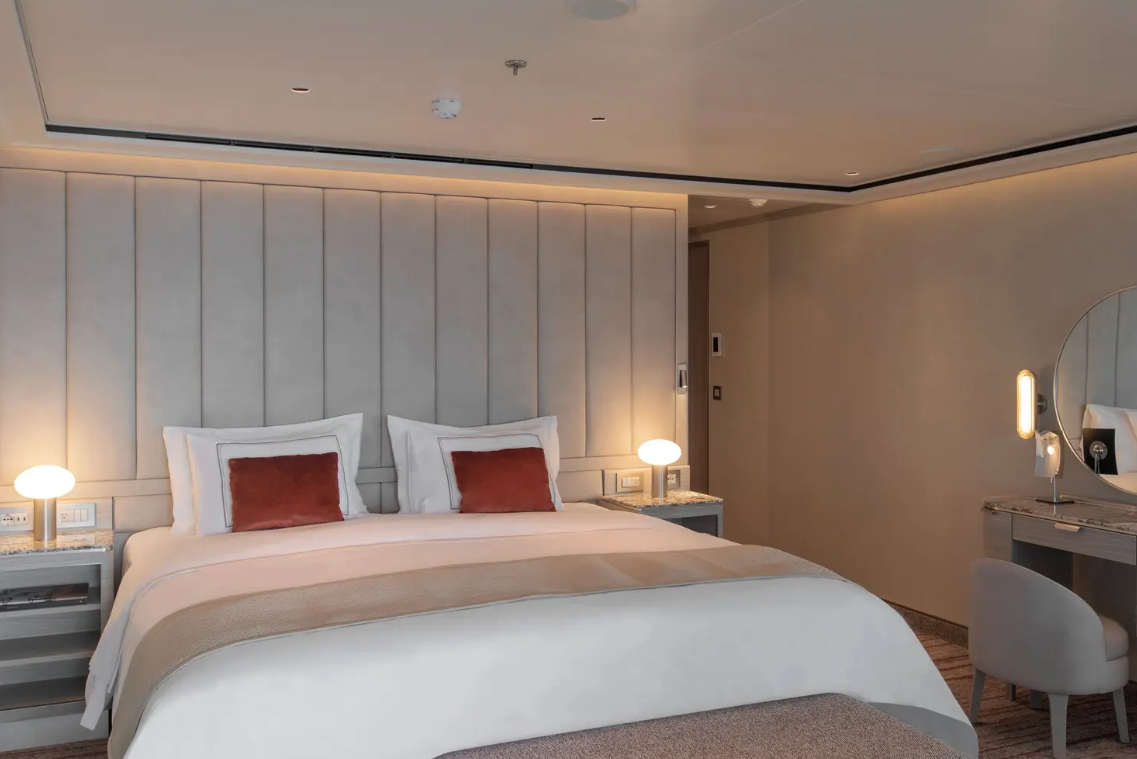
The Otium Suite is one of our newest and finest suites. Located in the premium aft corner position, the Otium Suite has a total size of 123 m2 (1,324 sq. ft.), including a 40 m2 (431 sq. ft.) balcony, which comes complete with a whirlpool. Features include a spacious living room area, a luxurious walk-in closet, a separate large bedroom, plus a bathroom with a whirlpool and walk-in shower. The crowning glory of the Otium Suite however must surely be its unprecedented 270 degree view, giving you some of the best views of your destination possible.
One bedroom: 123 sq.m. including veranda
Images are intended as a general reference. Features, materials, finishes and layout may be different than shown.
Please note the 3rd guest will sleep on a comfortable sofa bed in the reception area of suites that have 3rd berth capacity.
Essentials
- Deck(s): 6, 7
- Section: Aft
Characteristics
- Veranda
- Separate dining area
- Living room with sitting area
- Large vanity
- Separate shower
- Whirlpool bath
- Walk-in wardrobe with personal safe
Furniture
- King size bed
- Writing desk
- Vanity table
- Luxury bed mattresses (Custom made)
Media & Communication
- Unlimited Premium Wi-Fi
- 2 large flat screen TVs with Interactive Media Library
- Sound system with bluetooth connectivity
- Direct dial telephone
- Wall mounted USB-C mobile device chargers
- Dual voltage 110/220 outlets
Onboard Services
- Butler service
- Complimentary laundry, pressing & wet cleaning
- Daily canapé service, Welcome chocolate, Welcome fruit stand
- Dinner at the officer’s table
- Dinner for two in La Dame, one evening per voyage,
- Two hours of worldwide phone use, per voyage segment
- Priority check-in on embarkation day with early suite access
- Champagne on arrival
Amenities
- Espresso machine
- Pillow menu
- Refrigerator and bar setup stocked with your preferences
- Plush bathrobe
- Luxury bath amenities
- Umbrella
- Slippers
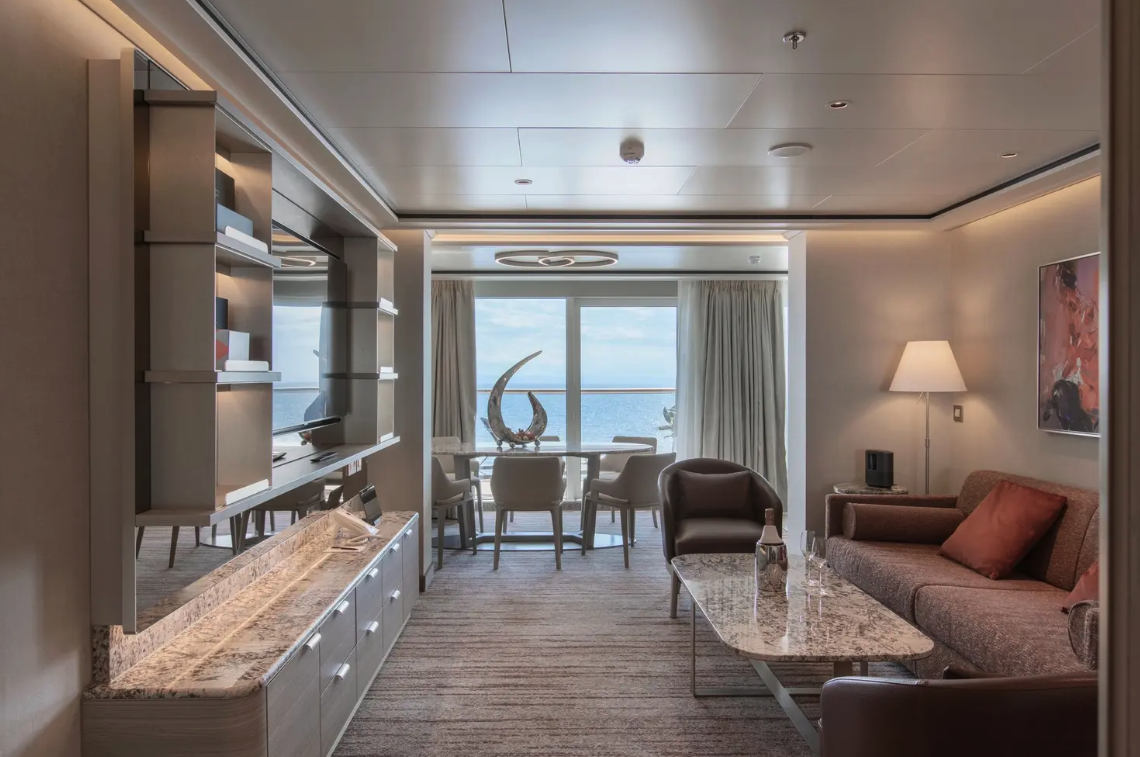
The eponymous Owner’s Suite is a Venetian Society favourite. So, why not travel in this stylish suite and get a taste of the ultimate in luxury lifestyle. The suite’s total size is a huge 98 m2 or 1055 sq. ft., which includes 16 m2 (172 sq. ft.) of balcony making for comfortable outdoor living. The favourite mid ship position gives incredible views from both the dining area and bedroom. A luxurious bathroom with double vanity, plus a whirlpool and walk-in shower, bidet, lavatory and guest restroom perfect the in-suite experience.
One bedroom: 98 sq.m. including veranda
Two bedroom: 131 sq.m. including veranda
Images are intended as a general reference. Features, materials, finishes and layout may be different than shown.
Please note the 3rd guest will sleep on a comfortable sofa bed in the reception area of suites that have 3rd berth capacity.
Essentials
- Deck(s): 8
- Section: Mid-Ship
Characteristics
- Veranda
- Separate dining area
- Living room with sitting area
- Large vanity
- Separate shower
- Whirlpool bath
- Walk-in wardrobe with personal safe
Furniture
- King size bed
- Writing desk
- Vanity table
- Luxury bed mattresses (Custom made)
Media & Communication
- Unlimited Premium Wi-Fi
- 2 large flat screen TVs with Interactive Media Library
- Sound system with bluetooth connectivity
- Direct dial telephone
- Wall mounted USB-C mobile device chargers
- Dual voltage 110/220 outlets
Onboard Services
- Butler service
- Complimentary laundry, pressing & wet cleaning
- Daily canapé service, Welcome chocolate, Welcome fruit stand
- Dinner at the officer’s table
- Dinner for two in La Dame, one evening per voyage,
- Two hours of worldwide phone use, per voyage segment
- Priority check-in on embarkation day with early suite access
- Champagne on arrival
Amenities
- Espresso machine
- Pillow menu
- Refrigerator and bar setup stocked with your preferences
- Plush bathrobe
- Luxury bath amenities
- Umbrella
- Slippers
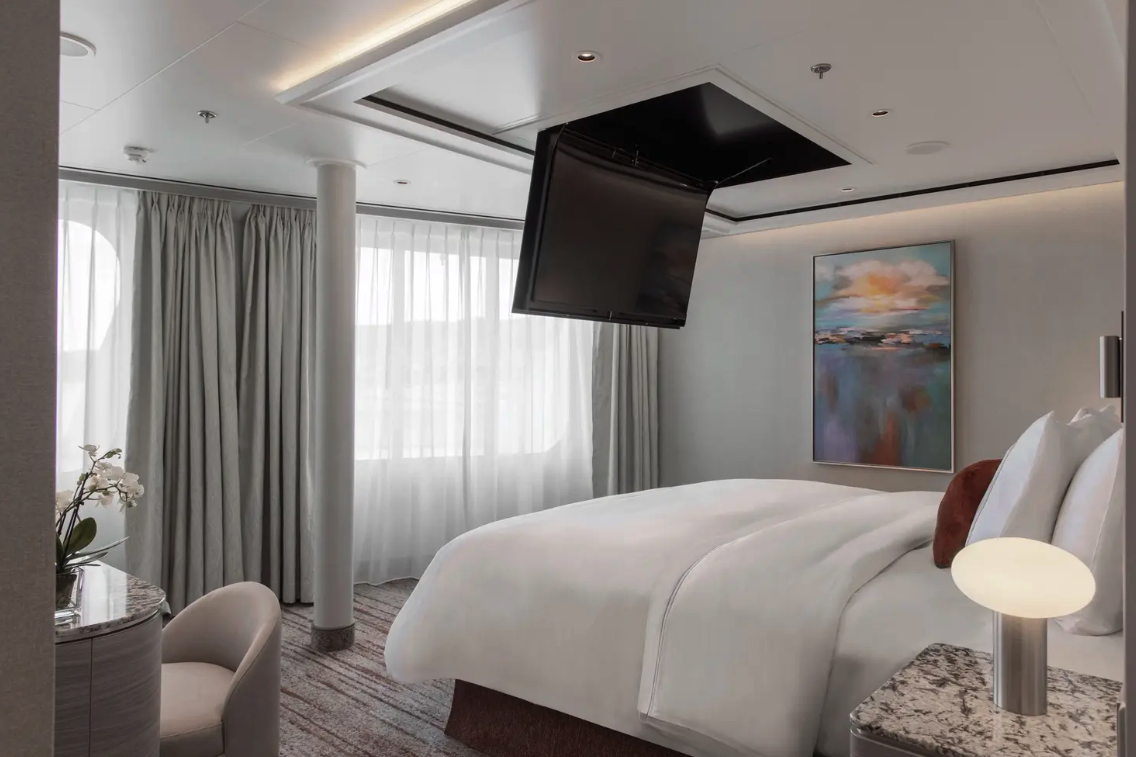
If you have ever wanted to indulge in one of our epitomes of ultra-luxury cruising, then the Grand Suite is perhaps the answer. Situated at the front of the ship, the Grand Suite offers sophistication and style for serious travellers. Thanks to an innovative design, the Grand Suite is one of the most luxurious and spacious suites aboard Silver Nova, offering sweeping sea to sky views on your destination from all living areas. A luxurious bathroom with double vanity, whirlpool and walk-in shower, plus a guest restroom complete.
One bedroom: 85 sq.m. including veranda
Two bedroom: 118 sq.m. including veranda
Images are intended as a general reference. Features, materials, finishes and layout may be different than shown.
Please note the 3rd guest will sleep on a comfortable sofa bed in the reception area of suites that have 3rd berth capacity.
Essentials
- Deck(s): 7
- Section: Forward
Characteristics
- Veranda
- Separate dining area
- Living room with sitting area
- Large vanity
- Separate shower
- Whirlpool bath
- Walk-in wardrobe with personal safe
Furniture
- King size bed
- Writing desk
- Vanity table
- Luxury bed mattresses (Custom made)
Media & Communication
- Unlimited Premium Wi-Fi
- 2 large flat screen TVs with Interactive Media Library
- Sound system with bluetooth connectivity
- Direct dial telephone
- Wall mounted USB-C mobile device chargers
- Dual voltage 110/220 outlets
Onboard Services
- Butler service
- Complimentary laundry, pressing & wet cleaning
- Daily canapé service, Welcome chocolate, Welcome fruit stand
- Dinner at the officer’s table
- Dinner for two in La Dame, one evening per voyage,
- Two hours of worldwide phone use, per voyage segment
- Priority check-in on embarkation day with early suite access
- Champagne on arrival
Amenities
- Espresso machine
- Pillow menu
- Refrigerator and bar setup stocked with your preferences
- Plush bathrobe
- Luxury bath amenities
- Umbrella
- Slippers
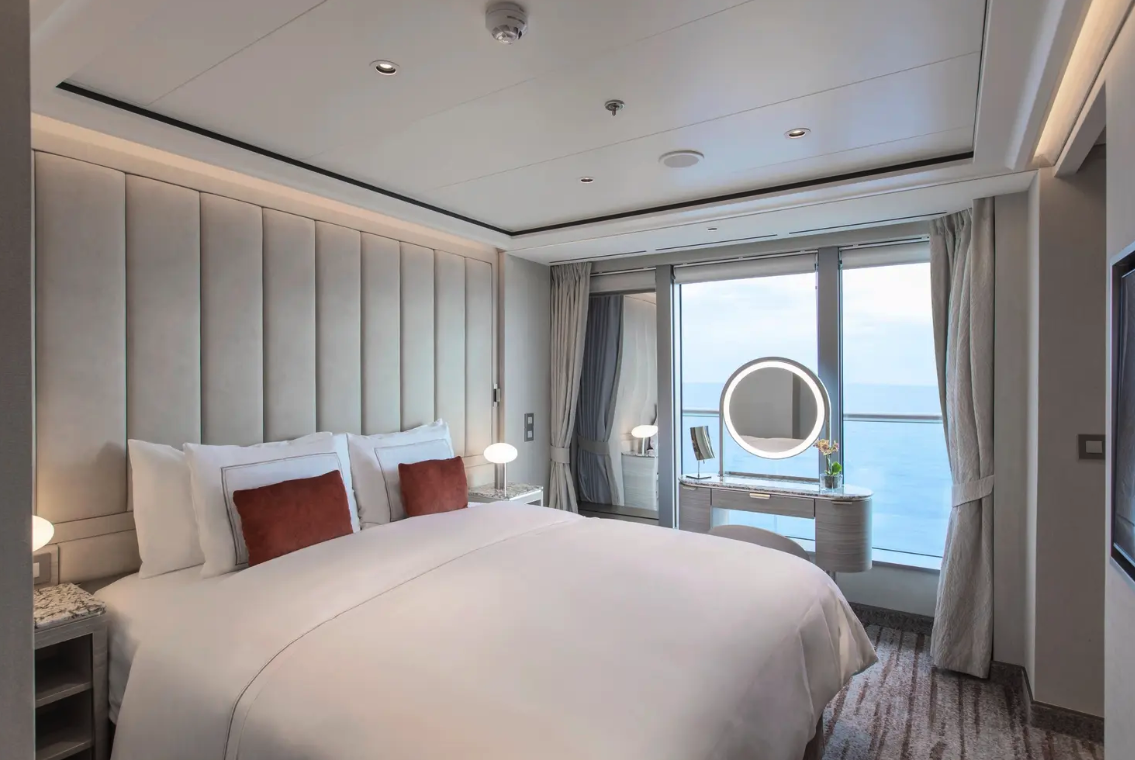
This new suite category is exclusive to Silver Nova. The Master Suite is stately, commanding and majestic and perfect for relaxing after a days’ exploring on shore. Located in the premium aft corner position, the Master Suite has a total size: 67-77 m2 (721-826 sq. ft) and includes 22-31m2 (233-330 sq. ft.) of balcony. The incredible floor-to-ceiling glazing surrounding the living room and bedroom area will offer outstanding 270° views on your destination, regardless of whether you are in the world. A sumptuous bathroom will feature sweeping views of the destination.
One bedroom: 67-77 sq.m. including veranda
Two bedroom: 100-110 sq.m. including veranda
Images are intended as a general reference. Features, materials, finishes and layout may be different than shown.
Please note the 3rd guest will sleep on a comfortable sofa bed in the reception area of suites that have 3rd berth capacity.
Essentials
- Deck(s): 6, 7, 8, 9
- Section: Aft
Characteristics
- Veranda
- Separate dining area
- Living room with sitting area
- Large vanity
- Separate shower
- Whirlpool bath
- Walk-in wardrobe with personal safe
Furniture
- King size bed
- Writing desk
- Vanity table
- Luxury bed mattresses (Custom made)
Media & Communication
- Unlimited Premium Wi-Fi
- 2 large flat screen TVs with Interactive Media Library
- Sound system with bluetooth connectivity
- Direct dial telephone
- Wall mounted USB-C mobile device chargers
- Dual voltage 110/220 outlets
Onboard Services
- Butler service
- Complimentary laundry, pressing & wet cleaning
- Daily canapé service, Welcome chocolate, Welcome fruit stand
- Dinner at the officer’s table
- Dinner for two in La Dame, one evening per voyage,
- Two hours of worldwide phone use, per voyage segment
- Priority check-in on embarkation day with early suite access
- Champagne on arrival
Amenities
- Espresso machine
- Pillow menu
- Refrigerator and bar setup stocked with your preferences
- Plush bathrobe
- Luxury bath amenities
- Umbrella
- Slippers

Another exclusivity for Silver Nova. The Signature Suite is one of our most distinctive new suites, offering unparalleled destination immersion through unobstructed views from all interior areas. The Signature Suite is one of the most spacious suites on board totalling 65 m2 or 700 sq. ft., including 16 m2 or 172 sq. ft. of balcony for superlative outdoor living. The innovative layout will feature a large dining and living room area, as well as a secluded bedroom. The large bathroom features a double vanity, whirlpool and walk-in shower and lavatory is completed by a guest restroom.
One bedroom: 65 sq.m. including veranda
Images are intended as a general reference. Features, materials, finishes and layout may be different than shown.
Please note the 3rd guest will sleep on a comfortable sofa bed in the reception area of suites that have 3rd berth capacity.
Essentials
- Deck(s): 6, 7, 8, 9
- Section: Mid-Ship
Characteristics
- Veranda
- Separate dining area
- Living room with sitting area
- Large vanity
- Separate shower
- Whirlpool bath
- Walk-in wardrobe with personal safe
Furniture
- King size bed
- Writing desk
- Vanity table
- Luxury bed mattresses (Custom made)
Media & Communication
- Unlimited Premium Wi-Fi
- 2 large flat screen TVs with Interactive Media Library
- Sound system with bluetooth connectivity
- Direct dial telephone
- Wall mounted USB-C mobile device chargers
- Dual voltage 110/220 outlets
Onboard Services
- Butler service
- Complimentary laundry, pressing & wet cleaning
- Daily canapé service, Welcome chocolate, Welcome fruit stand
- Dinner at the officer’s table
- Two hours of worldwide phone use, per voyage segment
- Priority check-in on embarkation day with early suite access
- Champagne on arrival
Amenities
- Espresso machine
- Pillow menu
- Refrigerator and bar setup stocked with your preferences
- Plush bathrobe
- Luxury bath amenities
- Umbrella
- Slippers
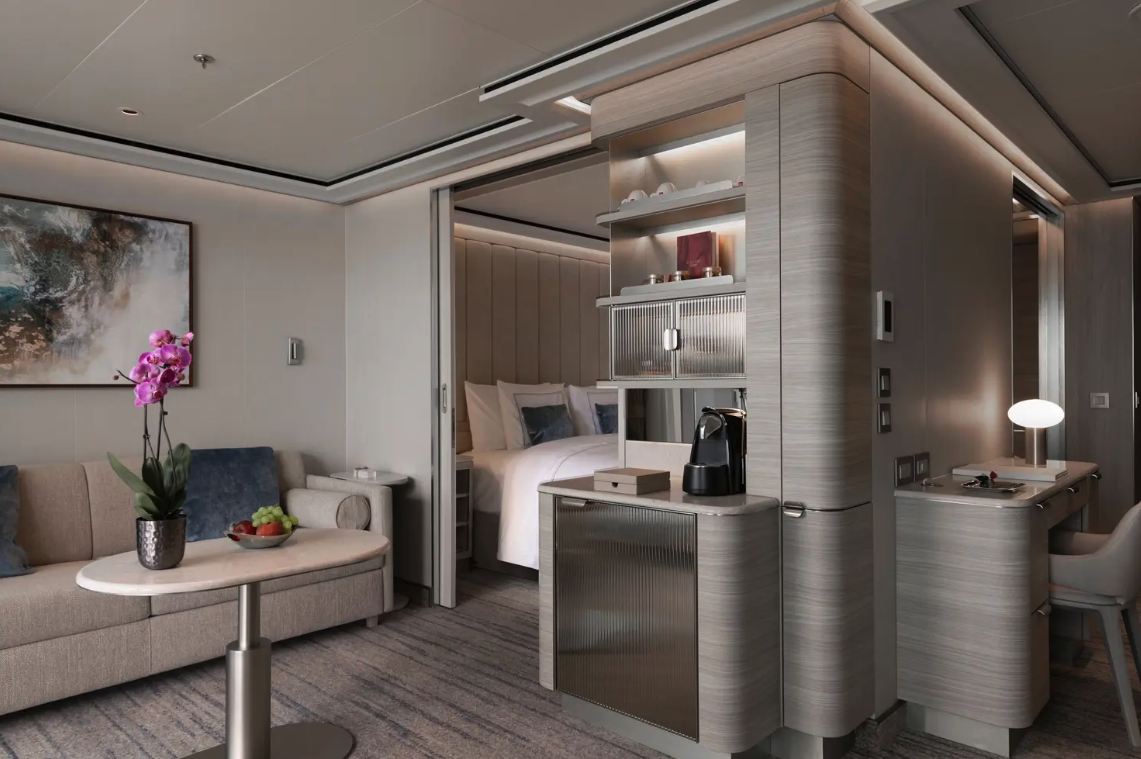
The Silver Suite is a Silversea favourite. It’s one of the Venetian Society’s favourite choices, and we can see why! The Silver Suite aboard Silver Nova offers an innovative design layout that will unlock full sea views from both the living room and bedroom, while the spacious living area allows for comfortable relaxing. A generous dining area makes cosy nights dining in veritable experiences in themselves. The suite features a generous walk-in closet as well as a bathroom with whirlpool bath, a walk-in shower, double vanity and separate lavatory.
One bedroom: 63 sq.m. including veranda
Two bedroom: 96 sq.m. including veranda
Wheelchair accessible suites: 6022, 7018
Images are intended as a general reference. Features, materials, finishes and layout may be different than shown.
Please note the 3rd guest will sleep on a comfortable sofa bed in the reception area of suites that have 3rd berth capacity.
Essentials
- Deck(s): 6, 7, 8
- Section: Mid-Ship
Characteristics
- Veranda
- Separate dining area
- Living room with sitting area
- Large vanity
- Separate shower
- Whirlpool bath (Except ADA suite (shower))
- Walk-in wardrobe with personal safe
Furniture
- King size bed
- Writing desk
- Vanity table
- Luxury bed mattresses (Custom made)
Media & Communication
- Unlimited Premium Wi-Fi
- 2 large flat screen TVs with Interactive Media Library
- Sound system with bluetooth connectivity
- Direct dial telephone
- Wall mounted USB-C mobile device chargers
- Dual voltage 110/220 outlets
Onboard Services
- Butler service
- Complimentary laundry, pressing & wet cleaning
- Daily canape service, Welcome chocolate, Welcome fruit stand
- Champagne on arrival
Amenities
- Espresso machine
- Pillow menu
- Refrigerator and bar setup stocked with your preferences
- Plush bathrobe
- Luxury bath amenities
- Umbrella
- Hair Dryer
- Slippers

Silver Nova’s Junior Grand Suite is a comfortably sized home away from home. Spaciously proportioned at 54-58 m2 or 581-624 sq. ft, including 6 m2 or 64 sq. ft of balcony, the Junior Grand builds on the success of the Grand Suite. It has inherited the best features of the Grand Suite by being positioned in the top bow position, offering spectacular views of the destination. The interior layout features a spacious living and dining area, as well as a secluded bedroom. The large bathroom features a double vanity, whirlpool and walk-in shower.
One bedroom: 54-58 sq.m. including veranda
Two bedroom: 87-91 sq.m. including veranda
Images are intended as a general reference. Features, materials, finishes and layout may be different than shown.
Please note the 3rd guest will sleep on a comfortable sofa bed in the reception area of suites that have 3rd berth capacity.
Essentials
- Deck(s): 6, 9
- Section: Forward
Characteristics
- Veranda
- Separate dining area
- Living room with sitting area
- Large vanity
- Separate shower
- Whirlpool bath
- Walk-in wardrobe with personal safe
Furniture
- King size bed
- Writing desk
- Vanity table
- Luxury bed mattresses (Custom made)
Media & Communication
- Unlimited Premium Wi-Fi
- 2 large flat screen TVs with Interactive Media Library
- Sound system with bluetooth connectivity
- Direct dial telephone
- Wall mounted USB-C mobile device chargers
- Dual voltage 110/220 outlets
Onboard Services
- Butler service
- Complimentary laundry, pressing & wet cleaning
- Daily canapé service, Welcome chocolate, Welcome fruit stand
- Champagne on arrival
Amenities
- Espresso machine
- Pillow menu
- Refrigerator and bar setup stocked with your preferences
- Plush bathrobe
- Luxury bath amenities
- Umbrella
- Slippers
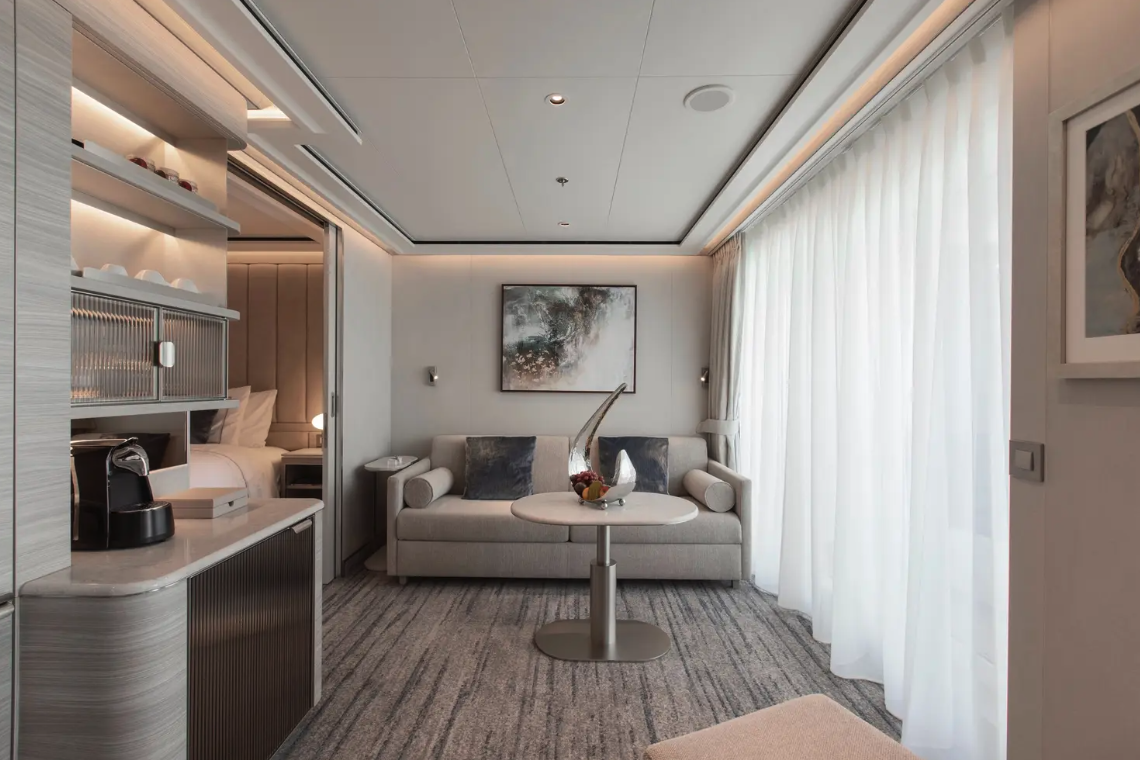
With features similar to our best-selling Medallion Suite, the Premium Medallion has an optimal placement at the aft. The Medallion Suite design builds on the phenomenal success of our iconic Veranda suite, while offering the comfort of a generous interior and balcony (49 m2/527 sq. ft. and 8 m2/86 sq. ft respectively). Additionally, the suite features a large bathroom with a double vanity, a spacious bathtub and separate shower, as well as a secluded bedroom area with king-size bed.
One bedroom: 49 sq.m. including veranda
Images are intended as a general reference. Features, materials, finishes and layout may be different than shown.
Please note the 3rd guest will sleep on a comfortable sofa bed in the reception area of suites that have 3rd berth capacity.
Essentials
- Deck(s): 6, 7, 8, 9
- Section: Aft, Mid-Ship
Characteristics
- Veranda
- Living room with sitting area
- Large vanity
- Separate shower
- Full-size bath
- Walk-in wardrobe with personal safe
Furniture
- King size bed
- Writing desk
- Vanity table
- Luxury bed mattresses (Custom made)
Media & Communication
- Unlimited Premium Wi-Fi
- 2 large flat screen TVs with Interactive Media Library
- Sound system with bluetooth connectivity
- Direct dial telephone
- Wall mounted USB-C mobile device chargers
- Dual voltage 110/220 outlets
Onboard Services
- Butler service
- Complimentary laundry, pressing & wet cleaning
- Daily canapé service, Welcome chocolate, Welcome fruit stand
- Champagne on arrival
Amenities
- Espresso machine
- Pillow menu
- Refrigerator and bar setup stocked with your preferences
- Plush bathrobe
- Luxury bath amenities
- Umbrella
- Slippers
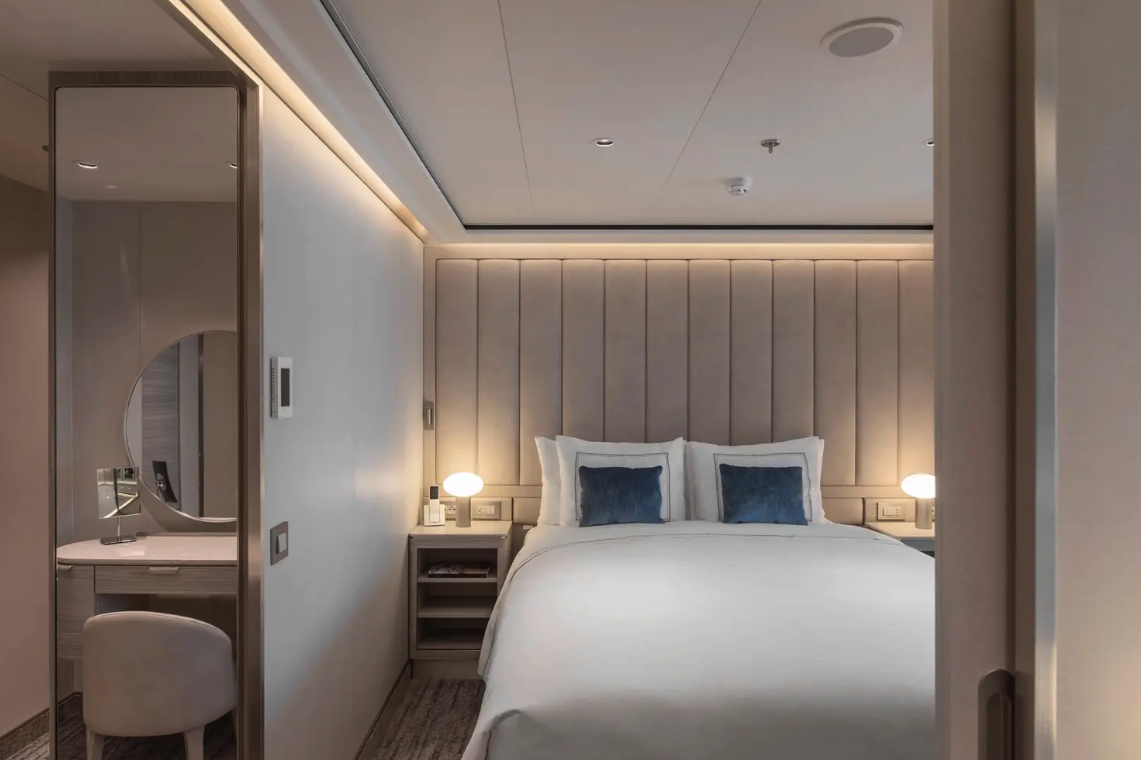
A mark of distinction, the Medallion Suite boasts a sumptuous and spacious living area, complete with rich textures and panoramic views from your large private veranda (8 m2 or 86 sq. ft.) Nestle up under plush bed linens for one of the best night’s sleep of your life, or rejuvenate after a busy day of exploring onshore in the cosy indoor sitting area (49 m2 or 527 sq. ft.) The large bathroom with double vanity, spacious bathtub and shower is the perfect place to soak the day away. Relax with ease in the Medallion Suite, as the grandeurs of this stateroom surround you with distinguished luxury.
One bedroom: 527 ft² / 49 m² including veranda
Images are intended as a general reference. Features, materials, finishes and layout may be different than shown.
Please note the 3rd guest will sleep on a comfortable sofa bed in the reception area of suites that have 3rd berth capacity.
Essentials
- Deck(s): 6, 7, 8, 9
- Section: Aft, Mid-Ship
Characteristics
- Veranda
- Living room with sitting area
- Large vanity
- Separate shower
- Full-size bath
- Walk-in wardrobe with personal safe
Furniture
- King size bed
- Writing desk
- Vanity table
- Luxury bed mattresses (Custom made)
Media & Communication
- Unlimited Premium Wi-Fi
- 2 large flat screen TVs with Interactive Media Library
- Sound system with bluetooth connectivity
- Direct dial telephone
- Wall mounted USB-C mobile device chargers
- Dual voltage 110/220 outlets
Onboard Services
- Butler service
- Complimentary laundry, pressing & wet cleaning
- Daily canapé service, Welcome chocolate, Welcome fruit stand
- Champagne on arrival
Amenities
- Espresso machine
- Pillow menu
- Refrigerator and bar setup stocked with your preferences
- Plush bathrobe
- Luxury bath amenities
- Umbrella
- Slippers
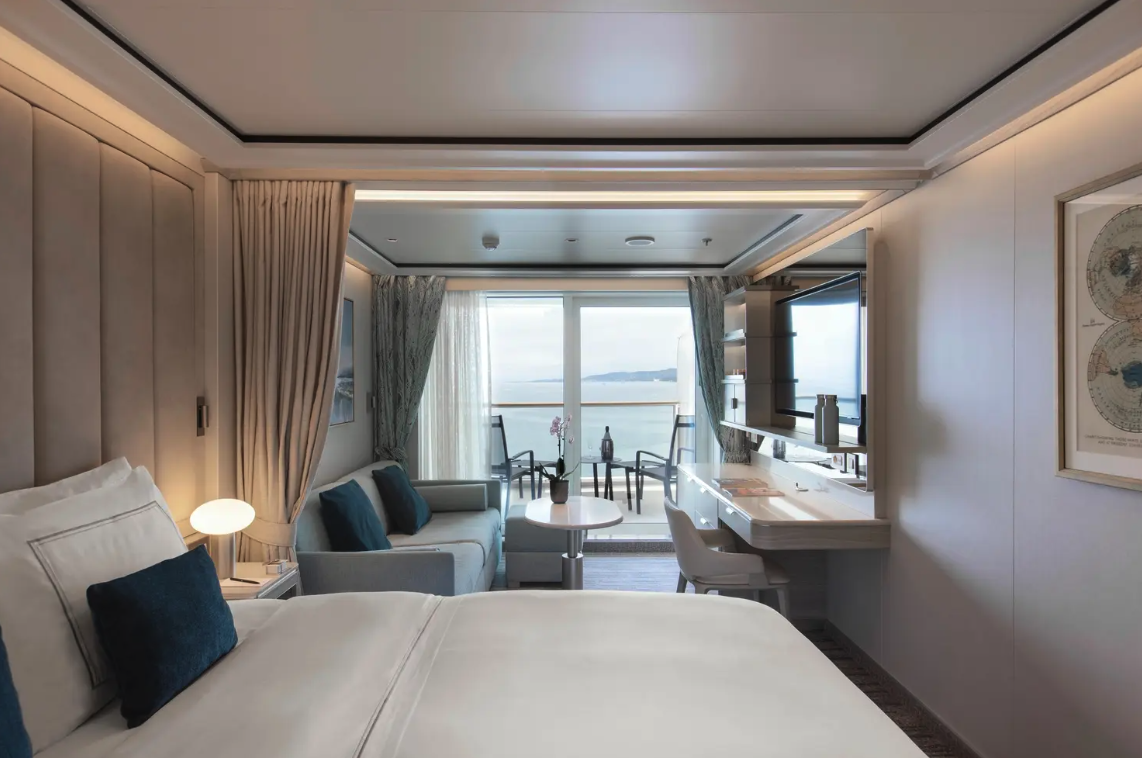
A Silversea signature, the Veranda Suite offers elegant décor, a stunning marbled bathroom with a luxurious double vanity and sumptuous walk-in shower or large bathtub. Located now in the top aft location, the Premium Veranda will offer a comfortable interior. Additionally, an ample sitting area provides a generous expanse of interior comforts. Four suites (one on each deck) will offer spacious interiors adapted for guests with disabilities which will be located in the ideal mid-ship position. A new iteration of our iconic and perfect suite configuration.
One bedroom: 33 sq.m. including veranda
Wheelchair accessible suites: 6045, 7037, 8031, 9041
Images are intended as a general reference. Features, materials, finishes and layout may be different than shown.
Please note the 3rd guest will sleep on a comfortable sofa bed in the reception area of suites that have 3rd berth capacity.
Essentials
- Deck(s): 6, 7, 8, 9
- Section: Aft, Mid-Ship
Characteristics
- Veranda
- Sitting area
- Large vanity
- Separate shower
- Some with full-size bath (Bath & shower combination (indicated with drop sign on deck plan))
- Walk-in wardrobe with personal safe
Furniture
- Queen size bed
- Writing desk
- Vanity table
- Luxury bed mattresses (Custom made)
Media & Communication
- Unlimited Standard Wi-Fi
- 1 large flat screen TV with Interactive Media Library
- Direct dial telephone
- Wall mounted USB-C mobile device chargers
- Dual voltage 110/220 outlets
Onboard Services
- Butler service
- Champagne on arrival
Amenities
- Pillow menu
- Refrigerator and bar setup stocked with your preferences
- Plush bathrobe
- Luxury bath amenities
- Umbrella
- Slippers
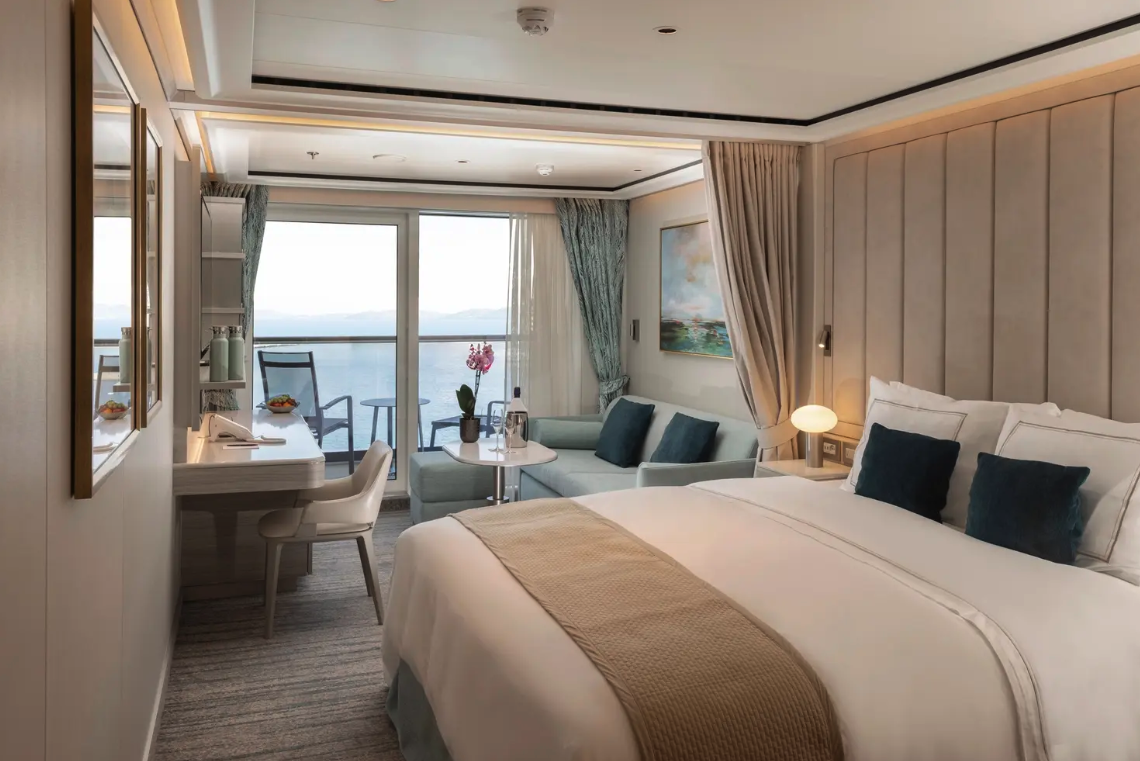
Whether you are preparing for a dynamic day on shore, primping for a romantic dinner on board, or settling down for a quiet evening in-suite, you will be enveloped by the Deluxe Veranda Suite’s warm touches. Located in the ideal mid-ship position, the Deluxe Veranda Suite offers a comfortable 33 m2 of interior luxury. But perhaps this suite’s finest asset lies just outside, as floor-to-ceiling glass doors open onto a furnished private teak 5 m2 veranda offering sweeping views of your destination.
One bedroom: 33 sq.m. including veranda
Two bedroom: 33 m² including veranda
Images are intended as a general reference. Features, materials, finishes and layout may be different than shown.
Please note the 3rd guest will sleep on a comfortable sofa bed in the reception area of suites that have 3rd berth capacity.
Essentials
- Deck(s): 6, 7, 8, 9
- Section: Aft, Mid-Ship
Characteristics
- Veranda
- Sitting area
- Large vanity
- Separate shower
- Some with full-size bath (Bath & shower combination (indicated with drop sign on deck plan))
- Walk-in wardrobe with personal safe
Furniture
- Queen size bed
- Writing desk
- Vanity table
- Luxury bed mattresses (Custom made)
Media & Communication
- Unlimited Standard Wi-Fi
- 1 large flat screen TV with Interactive Media Library
- Direct dial telephone
- Wall mounted USB-C mobile device chargers
- Dual voltage 110/220 outlets
Onboard Services
- Butler service
- Champagne on arrival
Amenities
- Pillow menu
- Refrigerator and bar setup stocked with your preferences
- Plush bathrobe
- Luxury bath amenities
- Umbrella
- Slippers

Well situated at the front and back of the ship, the 28 m2 interior of the Veranda Suite is only the beginning. The 5m2 teak balcony makes each spectacular sunset feel like it is yours alone. From beautiful bed linens to sumptuous furniture, our Superior Veranda suites are luxurious inside and out! Whether enjoying some down time with the state of the art entertainment system or taking in dinner in-suite, the Superior Veranda is the cosiest home away from home on the high seas.
One bedroom: 33 sq.m. including veranda
Images are intended as a general reference. Features, materials, finishes and layout may be different than shown.
Please note the 3rd guest will sleep on a comfortable sofa bed in the reception area of suites that have 3rd berth capacity.
Essentials
- Deck(s): 6, 7, 8, 9
- Section: Aft, Mid-Ship
Characteristics
- Veranda
- Sitting area
- Large vanity
- Separate shower
- Some with full-size bath (Bath & shower combination (indicated with drop sign on deck plan))
- Walk-in wardrobe with personal safe
Furniture
- Queen size bed
- Writing desk
- Vanity table
- Luxury bed mattresses (Custom made)
Media & Communication
- Unlimited Standard Wi-Fi
- 1 large flat screen TV with Interactive Media Library
- Direct dial telephone
- Wall mounted USB-C mobile device chargers
- Dual voltage 110/220 outlets
Onboard Services
- Butler service
- Champagne on arrival
Amenities
- Pillow menu
- Refrigerator and bar setup stocked with your preferences
- Plush bathrobe
- Luxury bath amenities
- Umbrella
- Slippers
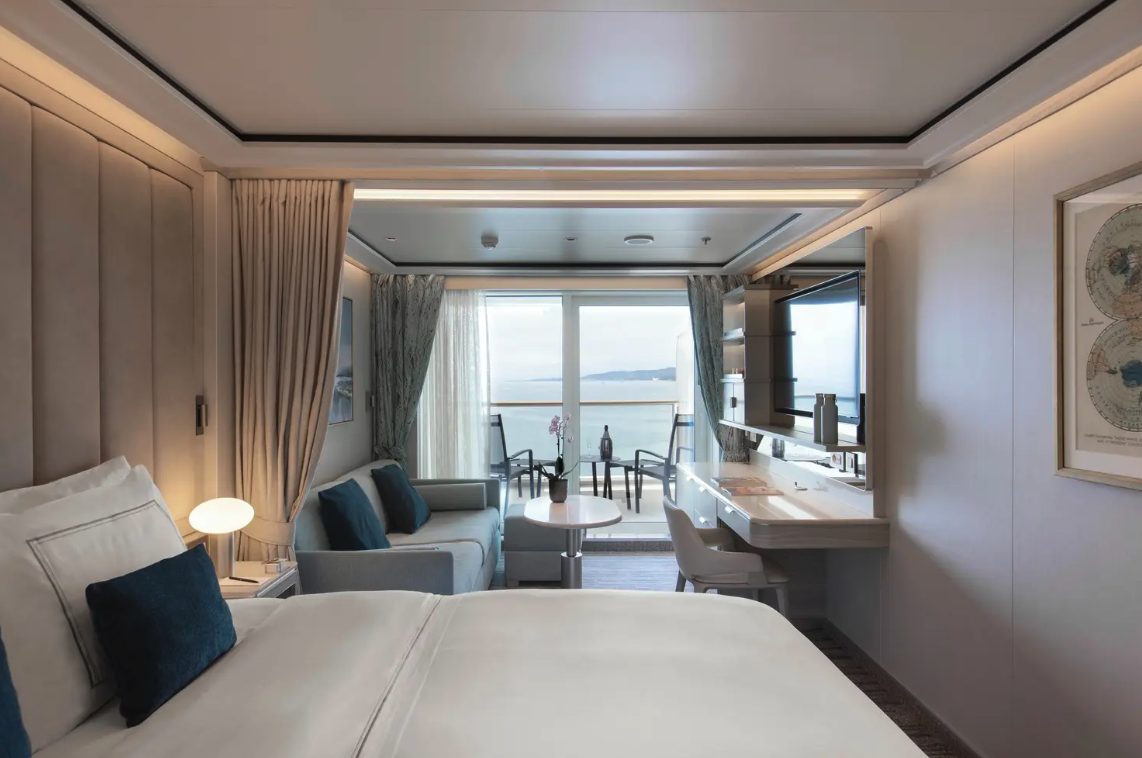
Located at the bow and aft of the ship, the Classic Veranda Suite will offer travellers a taste of our famous on board luxury. After a busy day of exploring, welcome home to the haven of the Classic Veranda Suite. With butler service, a queen size bed (which can be separated on demand) and beautiful marble bathroom, you won’t want to leave! However, the best part of our Classic Veranda suite is by far the large (5m2) private, teak veranda which offer sweeping views of the destination. Pure bliss.
One bedroom: 33 sq.m. including veranda
Images are intended as a general reference. Features, materials, finishes and layout may be different than shown.
Please note the 3rd guest will sleep on a comfortable sofa bed in the reception area of suites that have 3rd berth capacity.
Essentials
- Deck(s): 6, 7, 8, 9
- Section: Aft, Mid-Ship
Characteristics
- Veranda
- Sitting area
- Large vanity
- Separate shower
- Some with full-size bath (Bath & shower combination (indicated with drop sign on deck plan))
- Walk-in wardrobe with personal safe
Furniture
- Queen size bed
- Writing desk
- Vanity table
- Luxury bed mattresses (Custom made)
Media & Communication
- Unlimited Standard Wi-Fi
- 1 large flat screen TV with Interactive Media Library
- Direct dial telephone
- Wall mounted USB-C mobile device chargers
- Dual voltage 110/220 outlets
Onboard Services
- Butler service
- Champagne on arrival
Amenities
- Pillow menu
- Refrigerator and bar setup stocked with your preferences
- Plush bathrobe
- Luxury bath amenities
- Umbrella
- Slippers

The expansive, attractive Marquee houses two of our greatest dining successes. Thanks to Silver Nova’s groundbreaking asymmetrical design, we have been able to create an exciting new al fresco dining venue. The Marquee incorporates both The Grill and Spaccanapoli—two of Silversea’s existing signature venues, which offer guests our trademark ‘hot rocks’ culinary concept as well as what are surely the best pizzas at sea. The Marquee will welcome guests in a relaxed atmosphere, serving casual fare by day and dinner under the stars by night.
Images are intended as a general reference. Features, materials, finishes and layout may be different than shown.
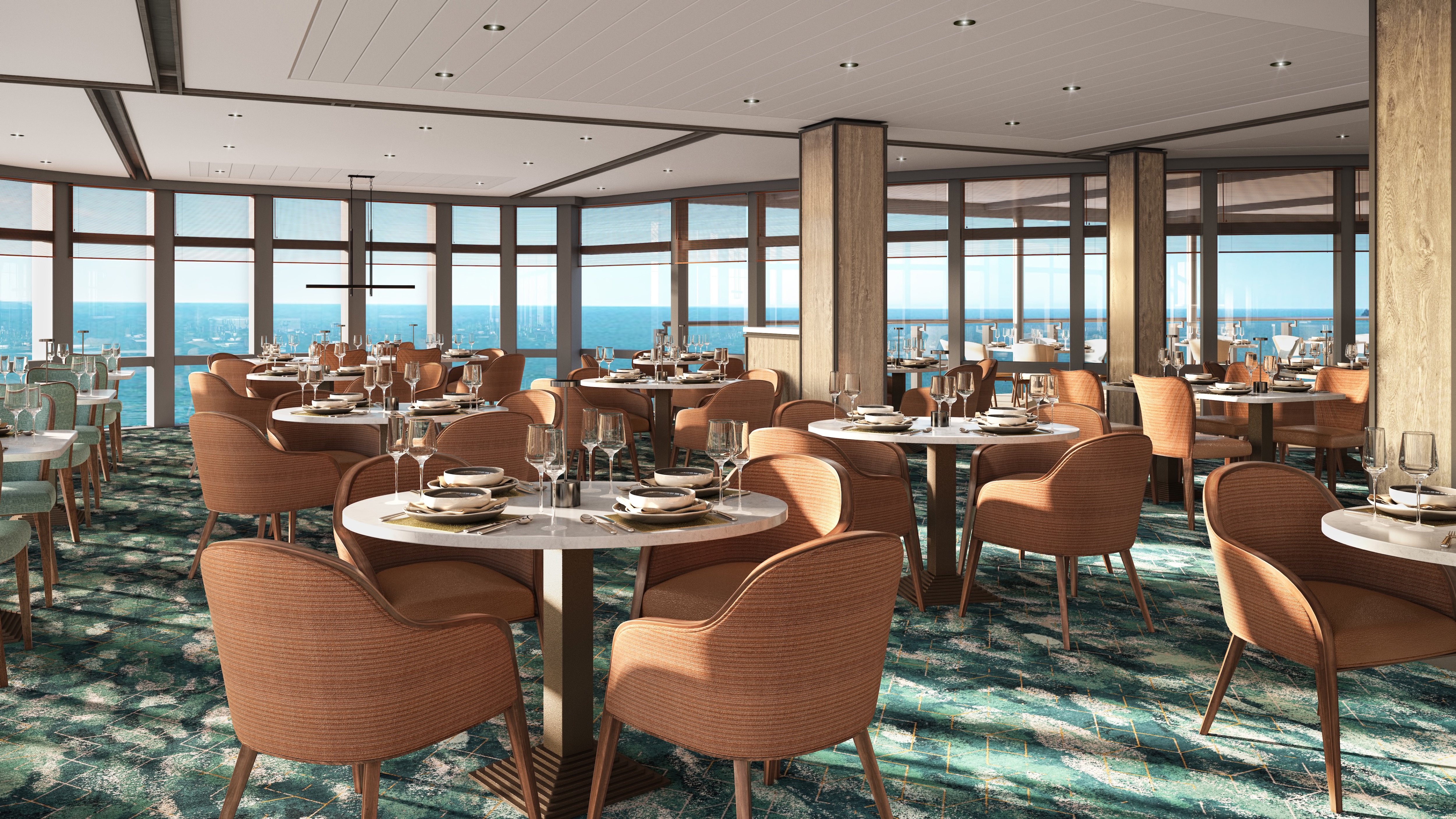
Our hallmark Italian restaurant is as varied as the food-loving country itself. La Terrazza aboard Silver Nova offers an unparalleled destination dining experience, from its expansive floor-to-ceiling windows to its large, outdoor terrace. Enjoy all the tastes of the different regions, including the best homemade pasta, fresh antipasto, bowls of steaming risotto, hearty ragu and delicious tiramisu. Be sure to try one of the bold wines from the cellar, to wash it all down.
Images are intended as a general reference. Features, materials, finishes and layout may be different than shown.
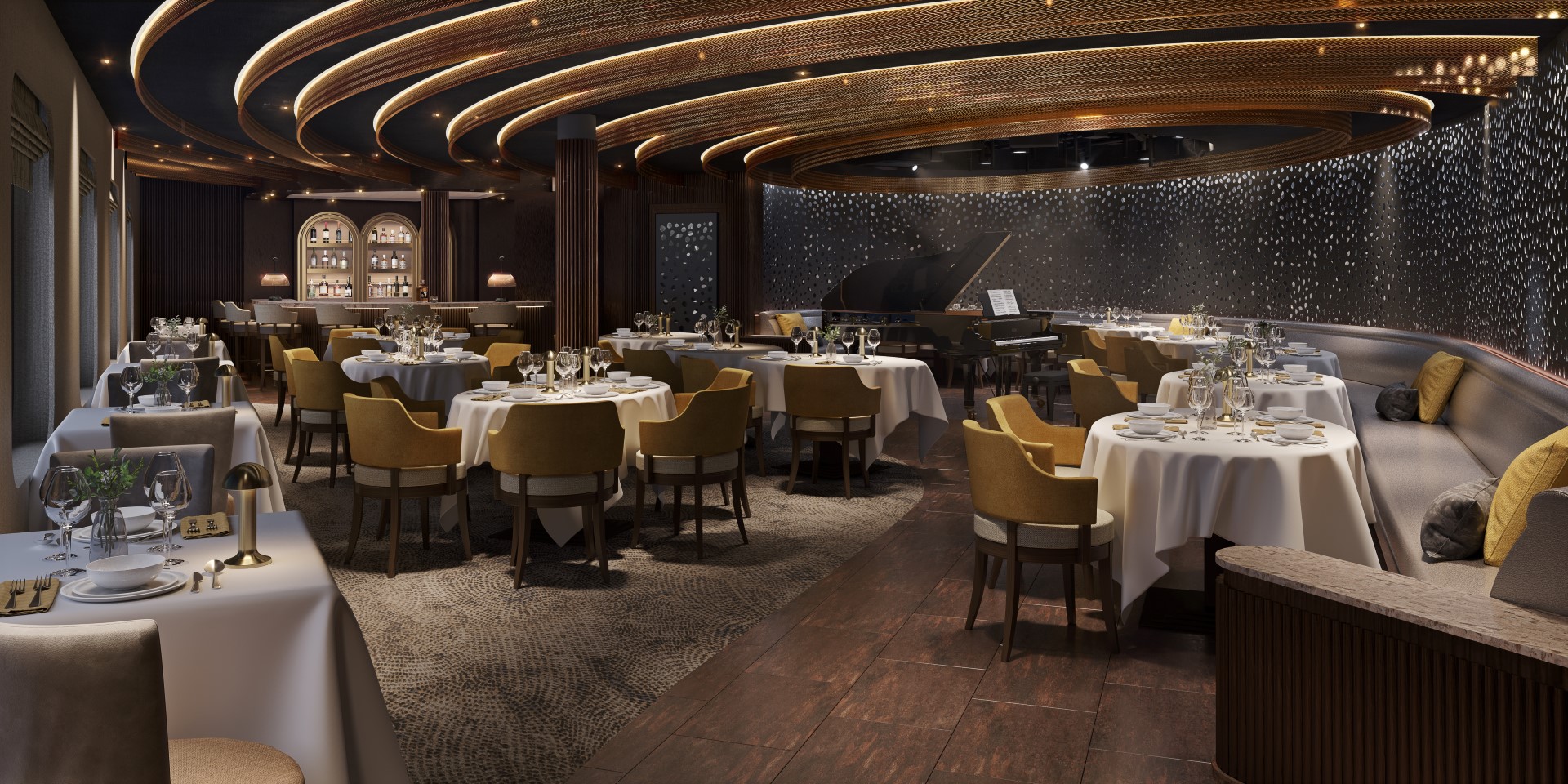
Where do you go if you want great food and a brilliant atmosphere in a relaxed and sophisticated setting? Silver Note of course! Harkening back to the old school days of dinner and dancing, this venue embodies a feeling of fun and sense of glamour that is unequalled in the industry. Jazz bands and soul singers play live as you sample delicate tapas style dishes with a gourmet twist. We guarantee a superlative night of entertainment in the gorgeously designed dinner venue.
Images are intended as a general reference. Features, materials, finishes and layout may be different than shown.
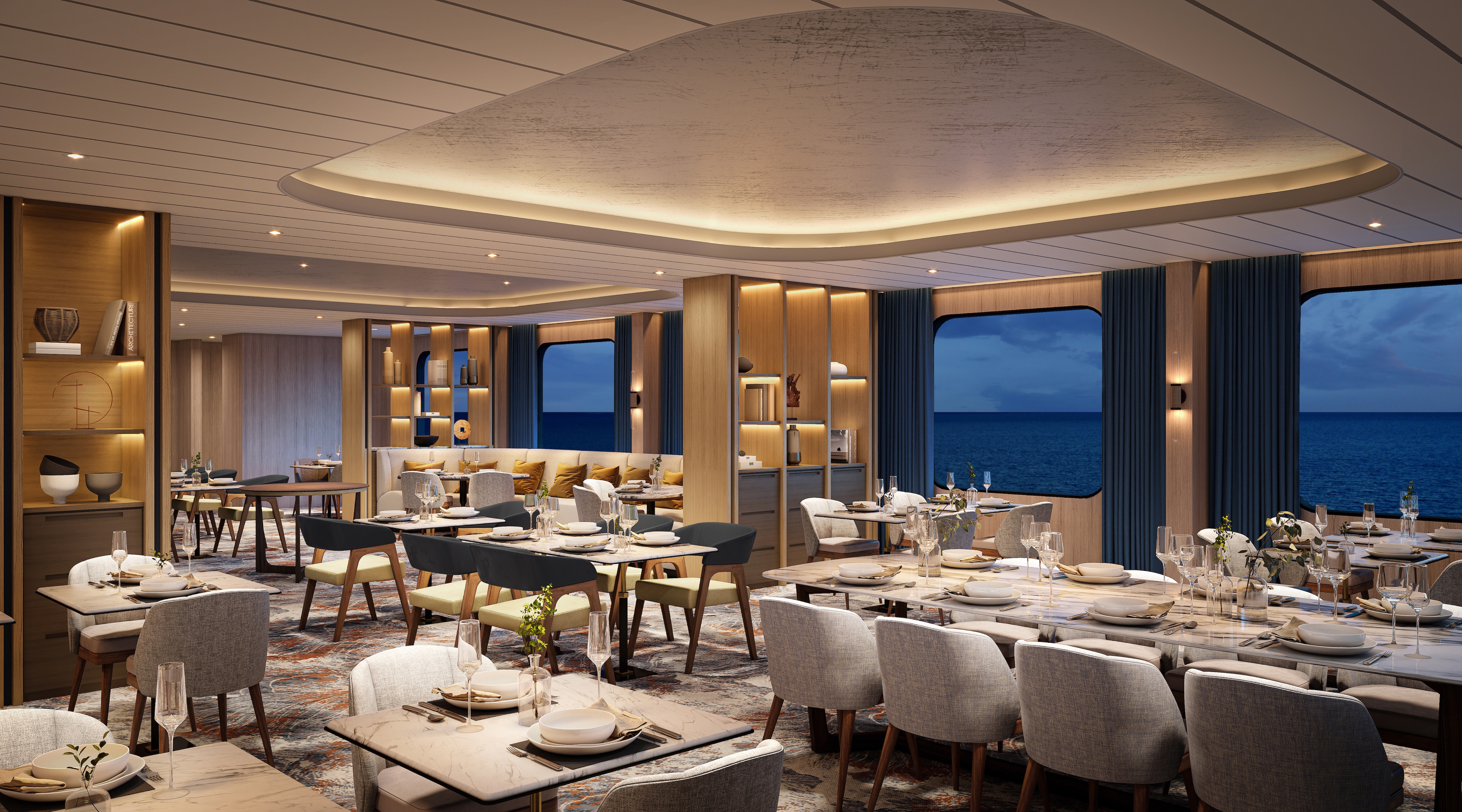
Are you hungry for something new? Eat your way through the places on your cruise in the S.A.L.T. Kitchen. Enjoy destination-inspired menus, including the Terrain menu, which offers recipes and flavours specific to the port visited, and the Voyage menu, which draws inspiration from the best flavours of the voyage. Pull up a chair and savour every taste of your cruise in a vibrant and welcoming atmosphere. S.A.L.T. Kitchen is the opportunity for all guests aboard Silver Nova to experience the very lifeblood of their destination.
Images are intended as a general reference. Features, materials, finishes and layout may be different than shown.

France’s haute cuisine is not world-famous for nothing! La Dame is a classy, contemporary, fine dining restaurant that is more beautiful and luxurious than ever. Enjoy polished French-inspired menus with deep, balanced flavours topped off by one of the best wine lists at sea, for a luxury dining experience extraordinaire! Signature Lalique crystal decor including the iconic Masque de Femme panels plus a stunning Hirondelles crystal chandelier bathe you in sophisticated, elegant décor.
Per guest reservation fee of US$60.
Images are intended as a general reference. Features, materials, finishes and layout may be different than shown.
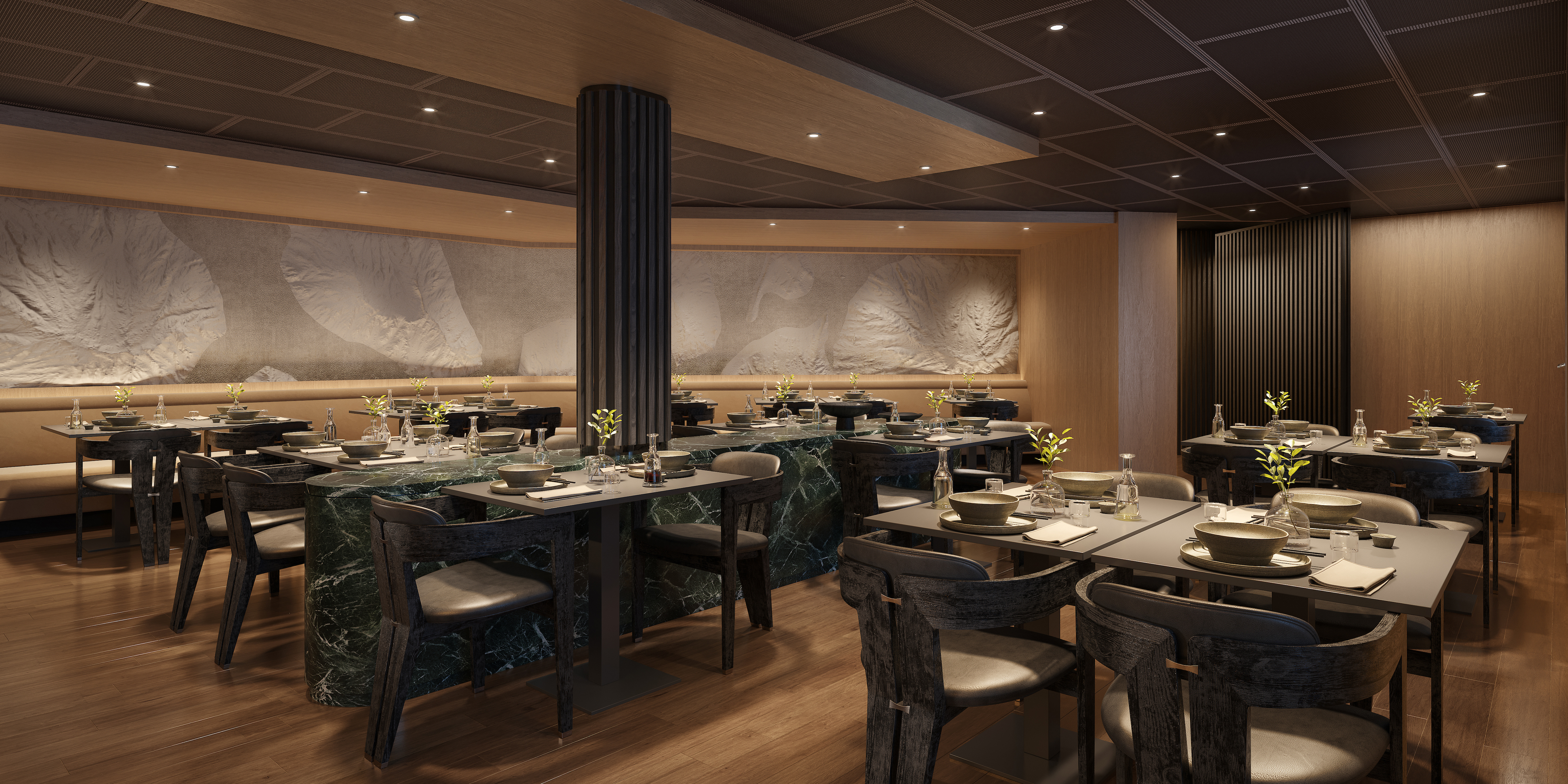
If you think Japanese food is only raw fish then think again. Certainly, we serve excellent sushi, but Kaiseki has so much more to offer. Watch the skilled chefs at work around the central teppanyaki table, soothed by the minimalist, authentic Japanese décor and calming ambience. The cuisine of the Land of the Rising Sun might be the speciality, but if you are craving Asian flavours then Kaiseki aboard Silver Nova extends its menu to include other Asian specialties such as Vietnamese, Thai, Indian, Korean and Chinese.
Per guest reservation fee of US$40.
Images are intended as a general reference. Features, materials, finishes and layout may be different than shown.

Atlantide offers guests our quintessential dining experience. Combining contemporary elegance and hallmark Silversea service, this classic restaurant offers our signature fine dining. Atlantide is one of our best-loved eateries, and on Silver Nova we have given it an updated design. Large picture windows, sophisticated lighting design, plus a warm colour spectrum give Atlantide a blend of high-end and whispered luxury. The menu prides itself on superb ingredients and sublime flavour combinations, from caviar to lobster to gorgeous, melt in the mouth deserts.
Images are intended as a general reference. Features, materials, finishes and layout may be different than shown.
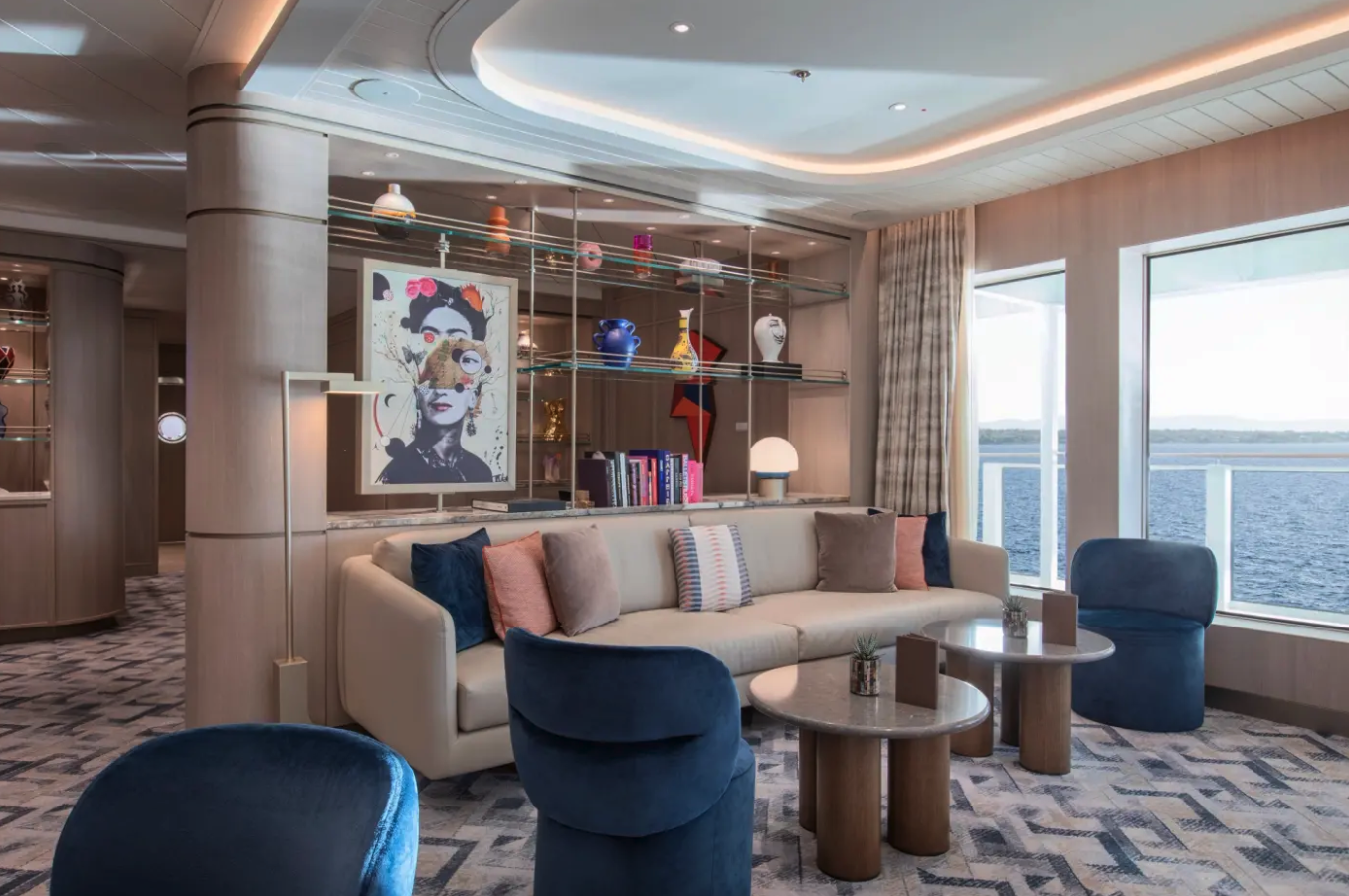
The Arts Café offers a cultural setting for eating, drinking and socialising, as well as a chance to lose yourself while reading up on all your favourite artists and art. Enjoy healthy snacks and smoothies plus hot and cold drinks, juices, pastries and sandwiches in a light and airy space. Pop in for a late breakfast or afternoon snack, along with real Italian espresso plus a great range of tea.
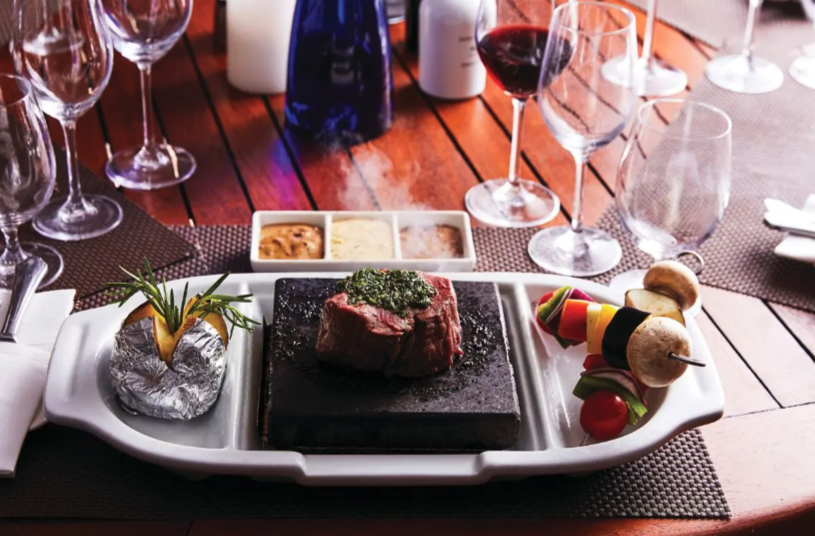
Silversea’s much-loved casual dining restaurants serves a delectable range of burgers and salads by day, and turns into our famous Hot Rocks table BBQ concept by night. Found in our brand new eating venue The Marquee, The Grill is quite simply, the best place to eat between sea and sky. If you like flavoursome meals cooked to perfection, a casual laid back atmosphere and OMG views, then The Grill is the answer to your prayers.
Images are intended as a general reference. Features, materials, finishes and layout may be different than shown.
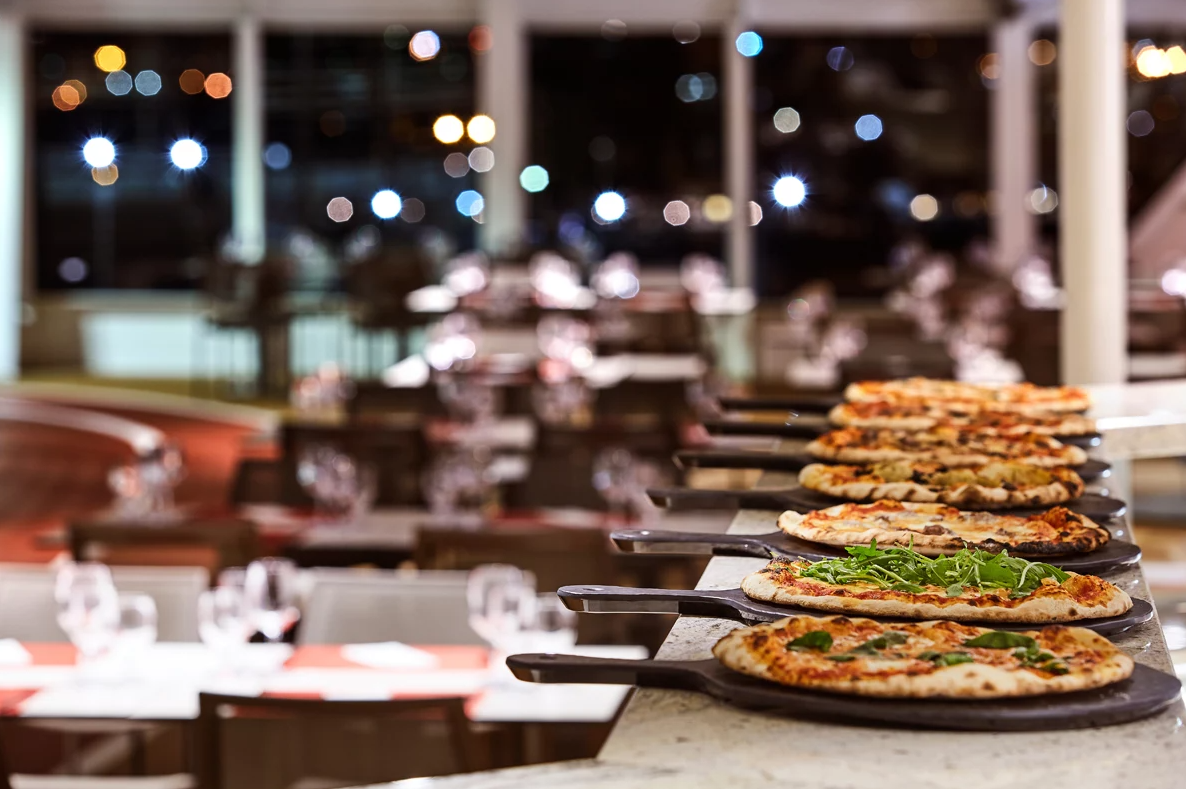
Nothing says Italy quite as well as a hot, fresh pizza. Spaccanapoli is a slice of Naples, where you’ll taste deliciously thin, freshly made pizzas, topped with creamy mozzarella and minimalist toppings. The light and airy pizzeria forms part of our new al-fresco eatery The Marquee, and is the perfect choice for diners who want to be dazzled by our talented pizzaiolos spinning the dough in the open-air kitchen. Whether you want a light lunch or to share a slice with friends over an aperitivo, it’s always the right time for Spaccanapoli.
Images are intended as a general reference. Features, materials, finishes and layout may be different than shown.
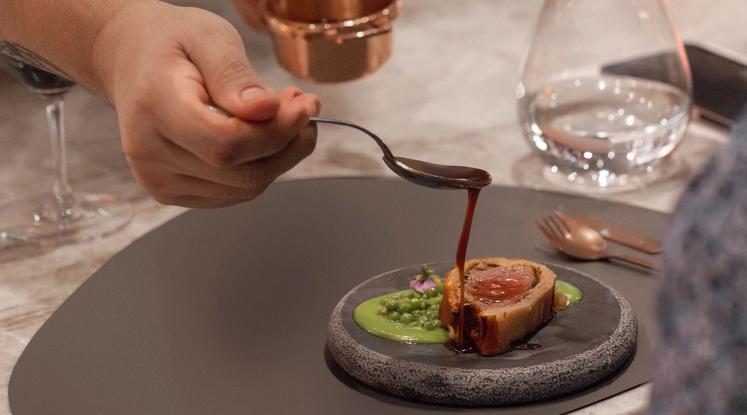
Prepare for an intimate and interactive dining experience like no other at the S.A.L.T. Chef’s Table. Indulge in a choreographed menu of small plates highlighting regional flavours and star ingredients, all accompanied by unique wines and cocktails.
Per guest reservation fee of U$180 (incl. complimentary wine & cocktail pairing). Reservations will be taken exclusively on board Silver Nova.
Images are intended as a general reference. Features, materials, finishes and layout may be different than shown.
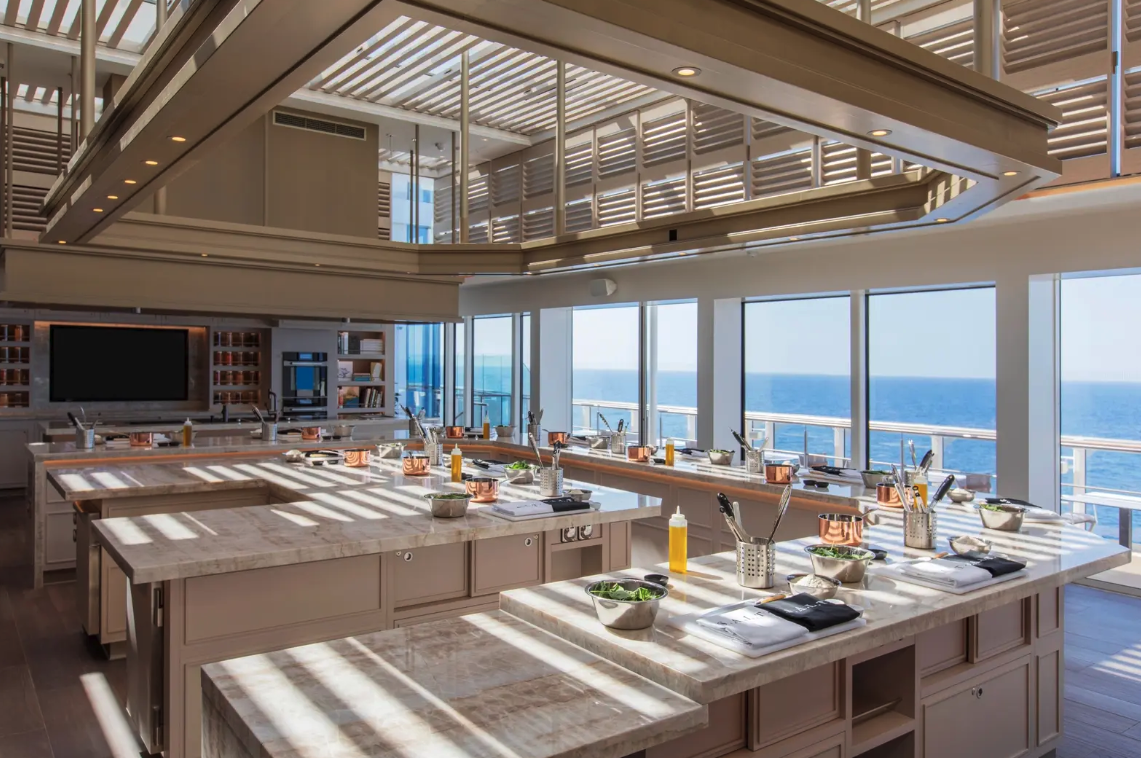
Welcome to the S.A.L.T. Lab, an interactive space where guests can deep-dive into local culinary heritage and techniques. Join our talented chefs and learn how your region’s food is central to its culture. Engage in your destination through workshops, lectures and cooking demonstrations for an authentic souvenir not available in any shop. The S.A.L.T. Lab is not just about food and flavour; it is a unique place where holistic destination immersion gives an entirely new dimension to travelling. This is where the magic happens!
Images are intended as a general reference. Features, materials, finishes and layout may be different than shown.
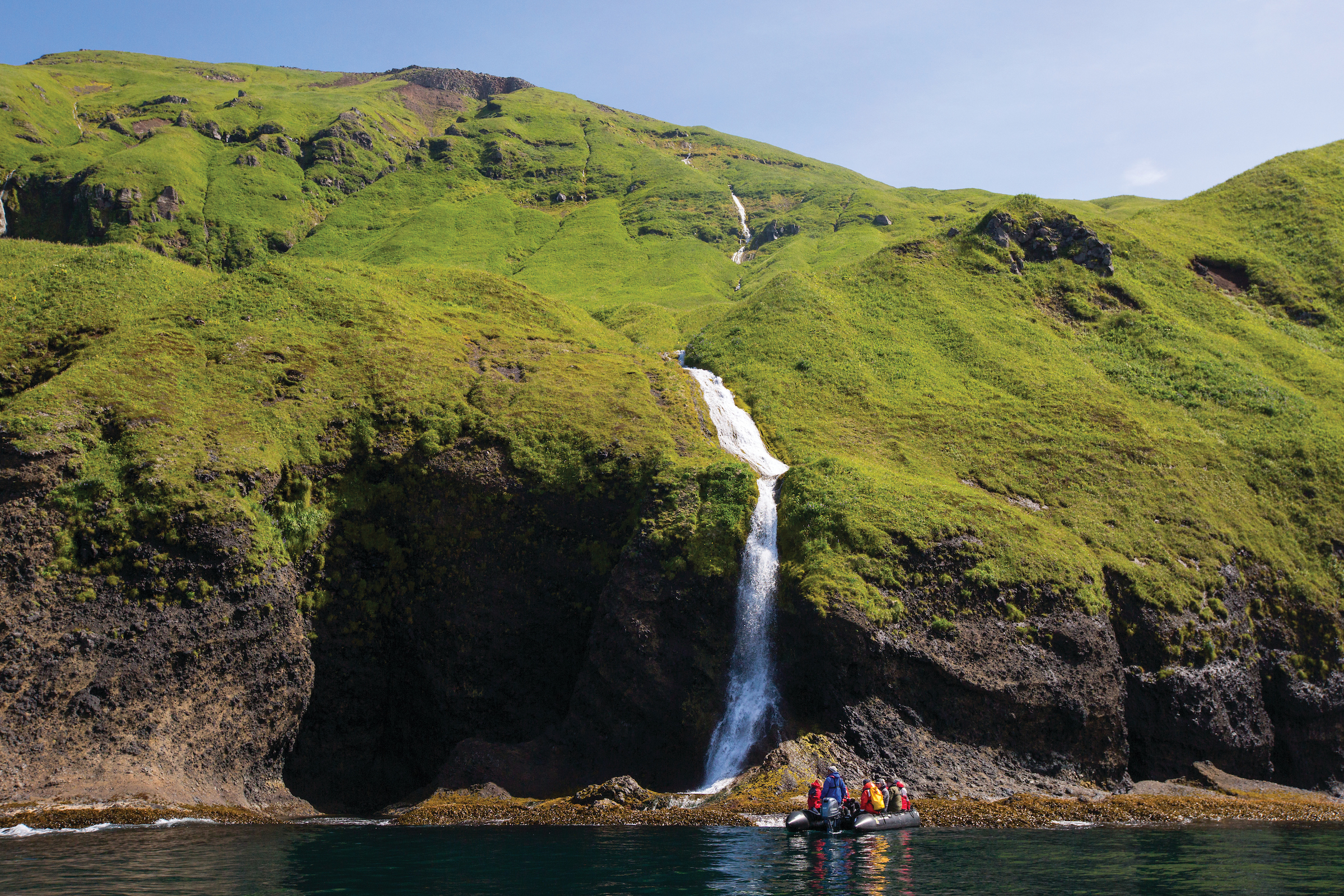
Silversea’s experienced Shore Concierge team are happy to assist, ensuring your shore- side experience is nothing less than a memory that lasts forever. Their knowledge and understanding of ports will truly add to your enjoyment and experience. Detailing history, local flavour, culture, regional customs, shopping tips and much more, they will make sure you get the best of your destination, wherever you are in the world.

Multiple days at sea mean plenty of R & R for some, but others prefer to drink in all there is to offer on land. Our Mid-Cruise Land Adventures allow you to take full advantage of your time with us without missing a single thing! These short escapades offer an array of adventures, break up your sea days and allow for deeper exploration beyond the coast.

Let Silversea customise a special event or excursion exclusively for you. Expert Shore Excursion professionals are available to assist with all your shorex questions. Make an appointment and gain insider access to knowledgeable suggestions, personalised planning and hassle-free coordination of all private, independent touring, including area highlights, flightseeing, water sports, and much more. Take advantage of this service either in advance of your voyage by email at shoreconcierge@silversea.com or on board by visiting the Silvershore® Concierge desk. Have the Silver Shore Concierge create your tailor-made tour, or be whisked away by private car for a day — the pace and agenda are up to you.
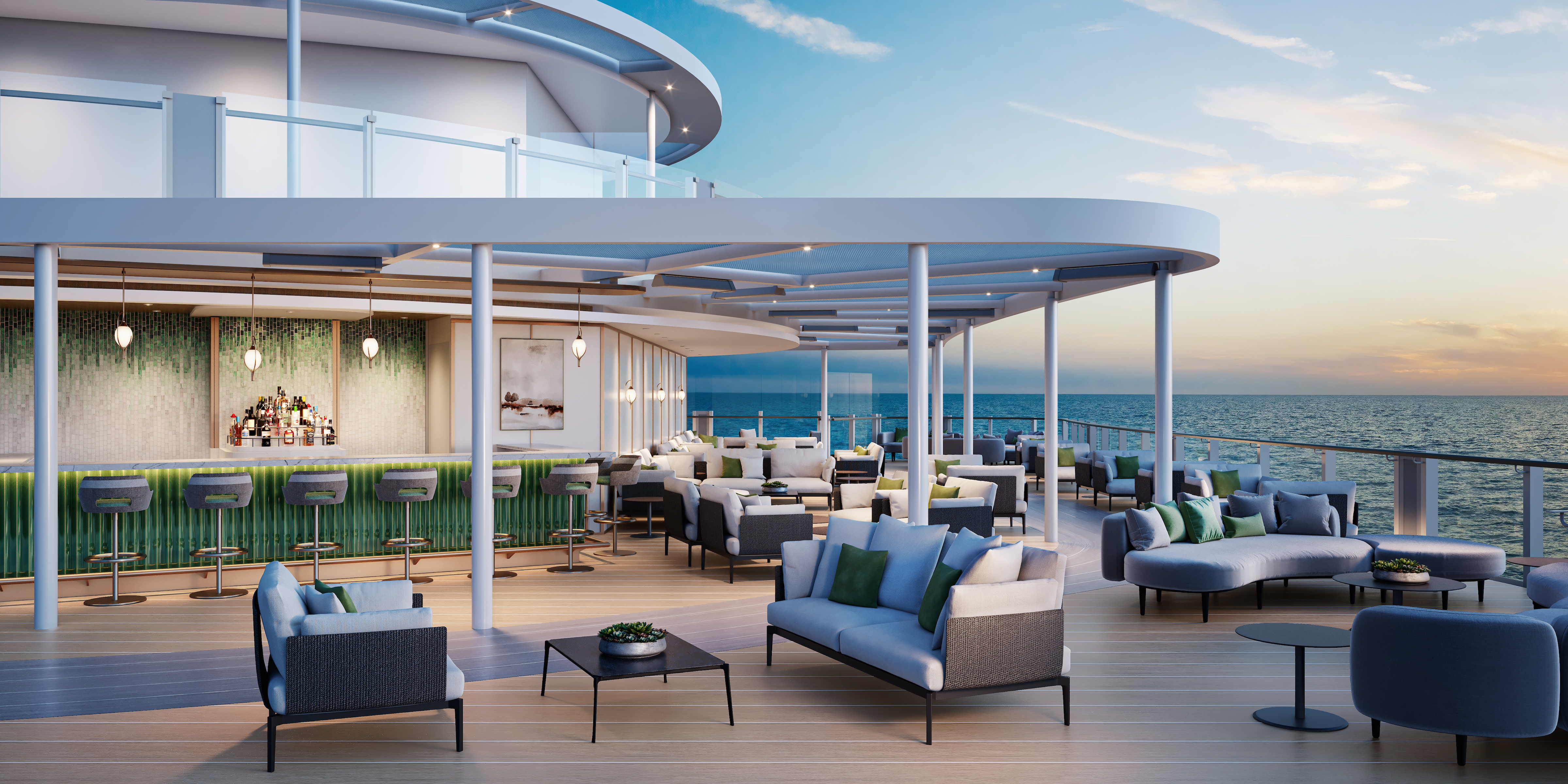
With an emphasis on the destination, panoramic views connects you with the world beyond on The Dusk Bar. This superb open-air sky bar provides plenty of space for guests to enjoy a pre or post dinner drink, while drinking in the jaw dropping 270-degree, panoramic views from the stern. The Dusk Bar’s blessed combination of idyllic atmosphere and lovely drinks will guarantee to tick your boxes time after time. Whether you’re enjoying a Spritz in South America, a cocktail in the Caribbean or a night cap in the Mediterranean, we think The Dusk Bar’s unobstructed views give you a new perspective on sunsets at sea.
Images are intended as a general reference. Features, materials, finishes and layout may be different than shown.
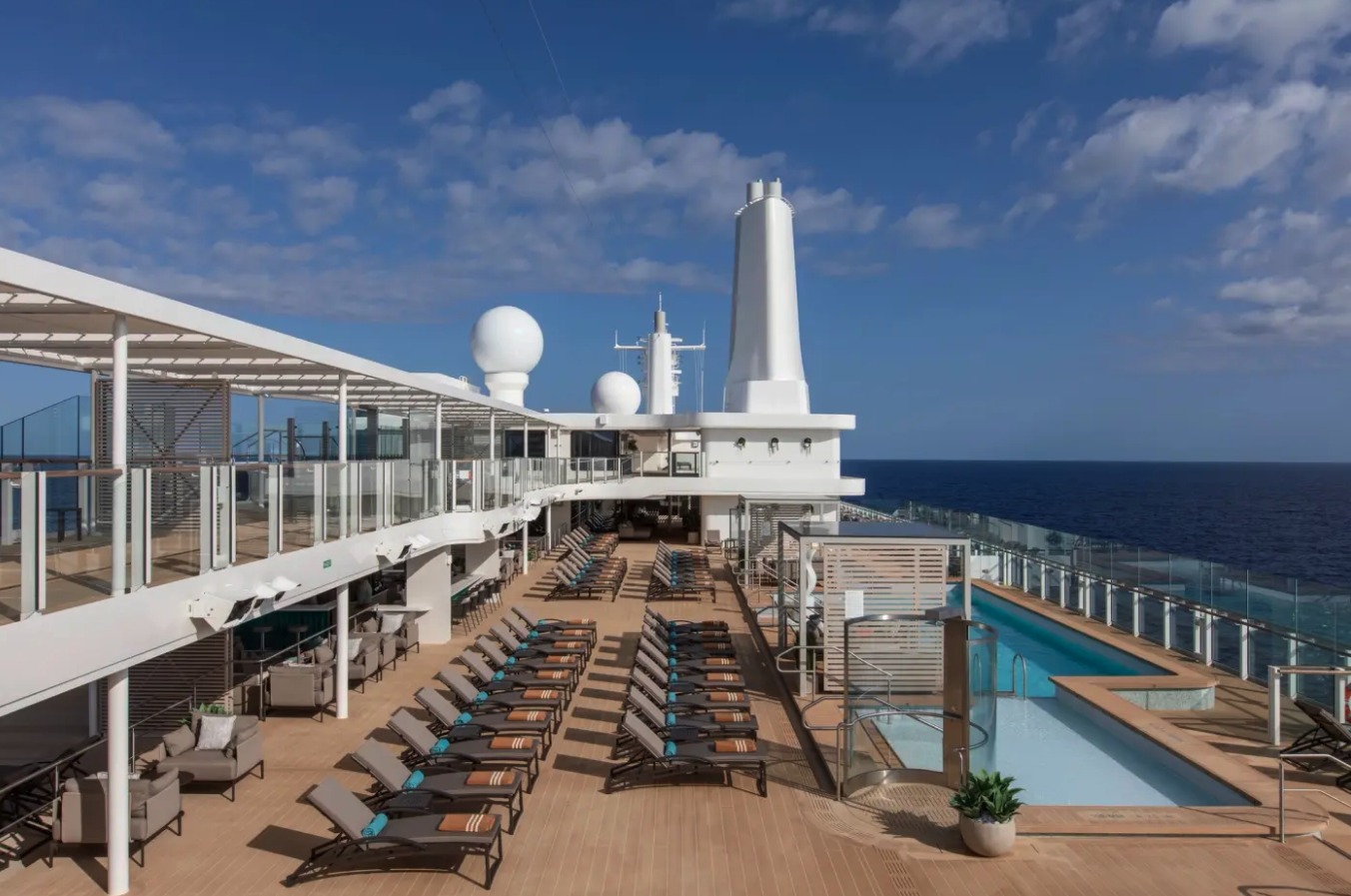
Enjoy a reimagined space where you can relax, refresh and rejuvenate on decks 10 and 11. Ample sunbeds for everyone, more space than ever before and the largest pool in the fleet – which offers exceptional 270˚ unhampered views – are just the beginning. The upper level sun deck is perfectly placed for those who want a quieter space to relax, and still enjoy those incredible, expansive views that are the hallmark of Silver Nova. But it is The Cliff Whirlpool, an infinity edge, glass fronted whirlpool, that really makes The Pool Deck something special.
Images are intended as a general reference. Features, materials, finishes and layout may be different than shown.
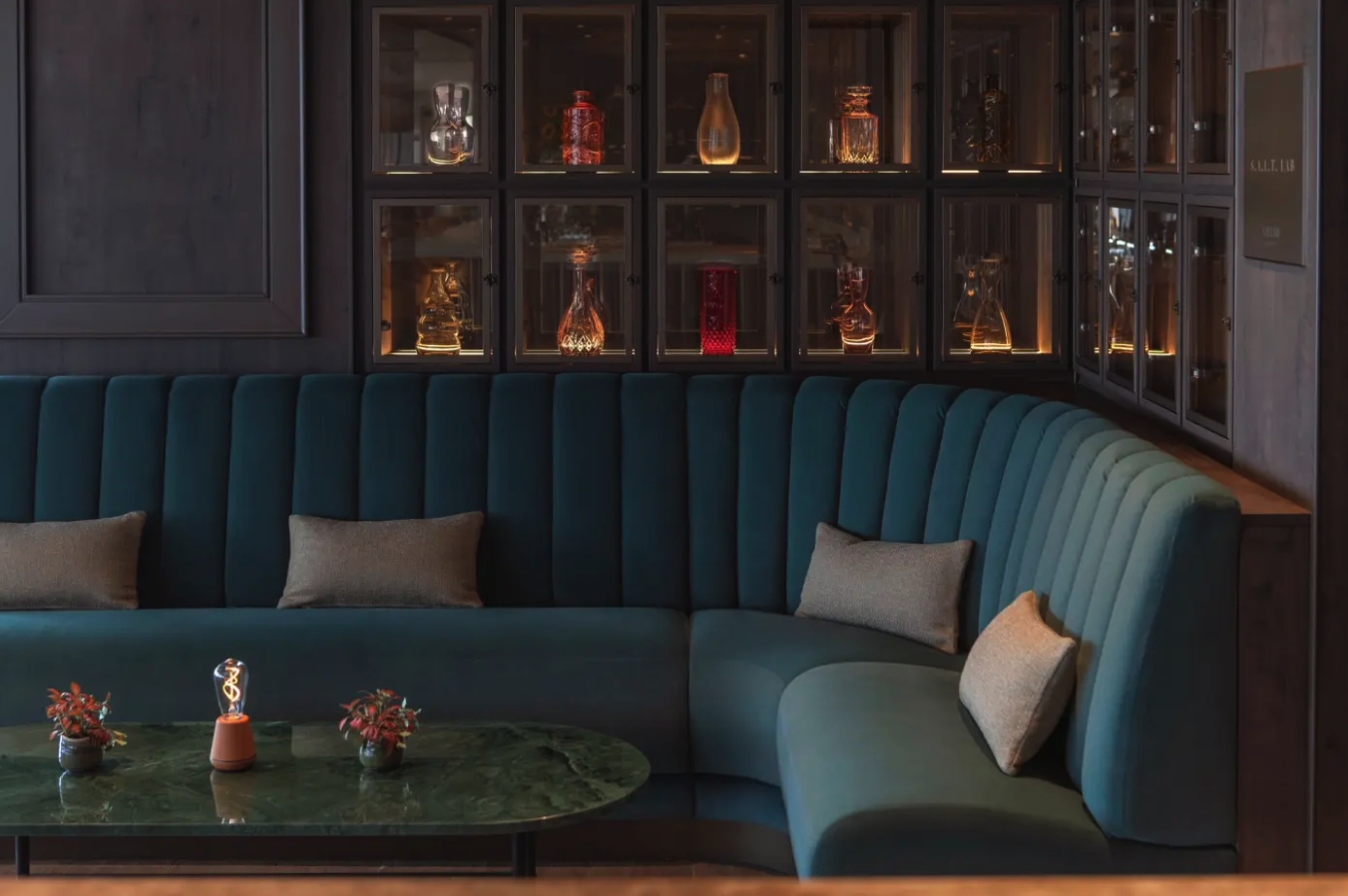
Nothing says authentic experience better than Silver Nova’s S.A.L.T. Bar. Get a taste for the authentic and settle down to enjoy locally-inspired cocktails and drinks. How can you go wrong with a Rum Punch in Barbados, a Pastis over ice in Marseille or a Pisco Sour in Lima? Nothing unites new faces and old friends in quite the same way. Be inspired to find your perfect locally-inspired beverage at the S.A.L.T. Bar and let in the colour and flavours of your journey rush in.
Images are intended as a general reference. Features, materials, finishes and layout may be different than shown.
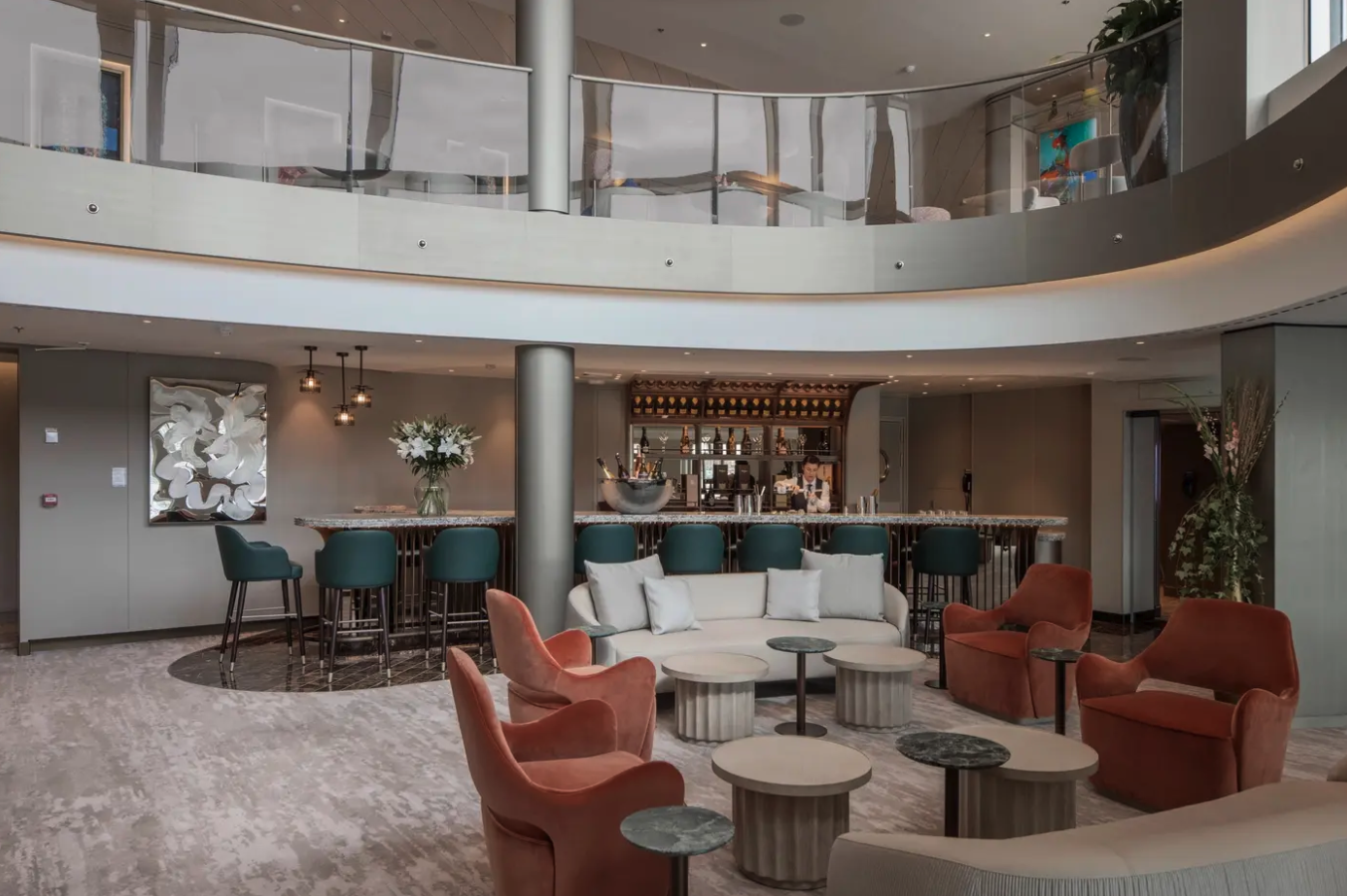
The Shelter is our newest pre and post dinner cocktail venue. Settle in amid an intimate and elegant setting, resplendent with sophisticated lighting, inviting sofas and stunning wraparound bar. Strategically located on deck three, the atmospheric hideaway opens onto the Atrium, creating an openness and connection to the other neighbouring venues. We promise you’ll fall in love with one of the best bars on board while our talented team of mixologists mix and shake our range of signature and bespoke cocktails. With itis the perfect destination, warm smiles and legendary Silversea service, get set for unforgettable nights in The Shelter.
Images are intended as a general reference. Features, materials, finishes and layout may be different than shown.
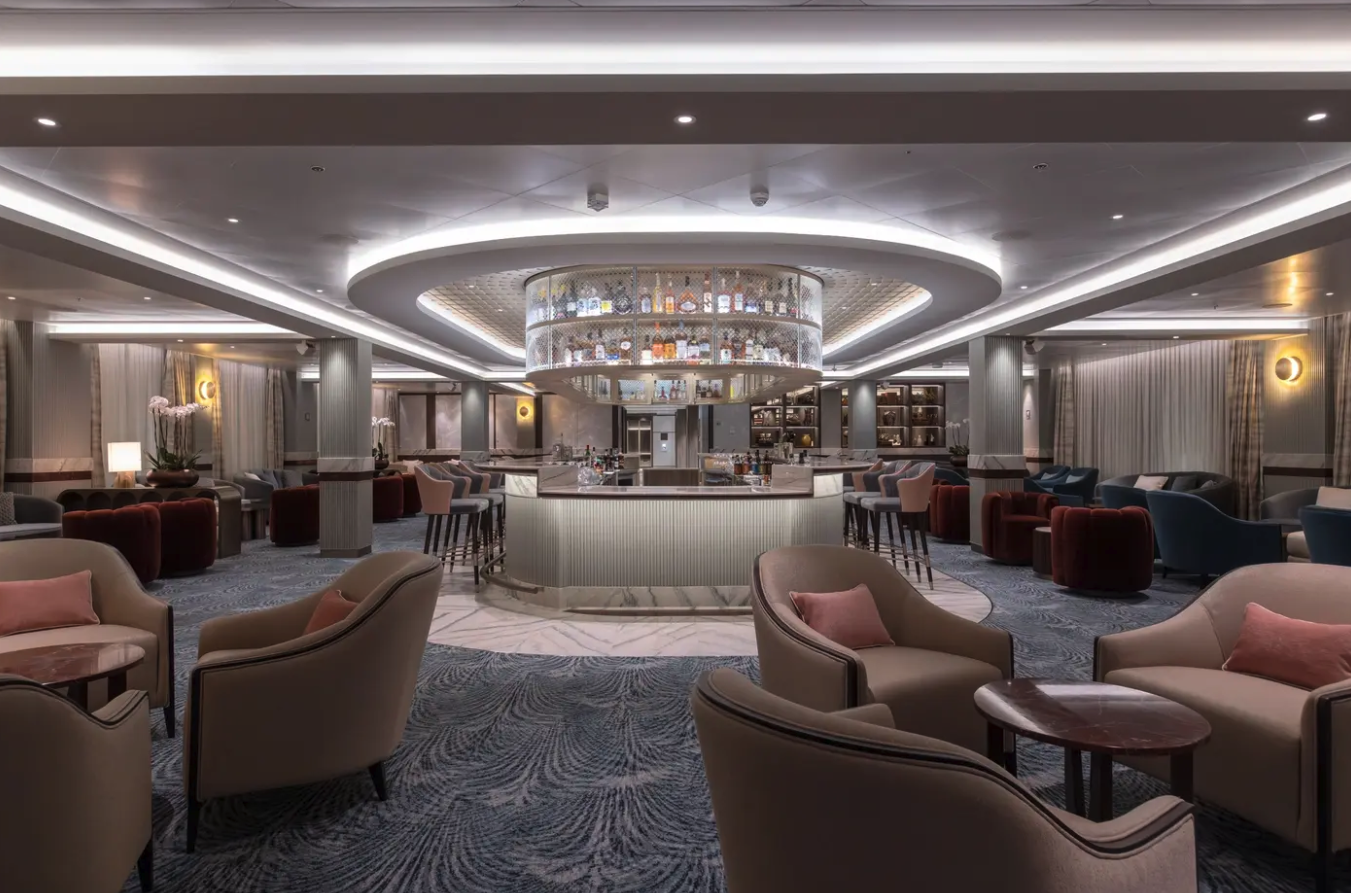
Our main bar has been newly reimagined for Silver Nova! Dolce Vita has of course kept her legendary charm, inspired cocktails, stylish décor and comfortable seating, but a central bar now means the warm ambience is better than ever! Oozing Italian glamour, Dolce Vita is a relaxed, refined bar with a nightly piano player playing all your favourite tunes. Perfect for pre-dinner aperitivi, or even a post-dinner cocktail, Dolce Vita is truly the beating heart of social life on board.
Images are intended as a general reference. Features, materials, finishes and layout may be different than shown.
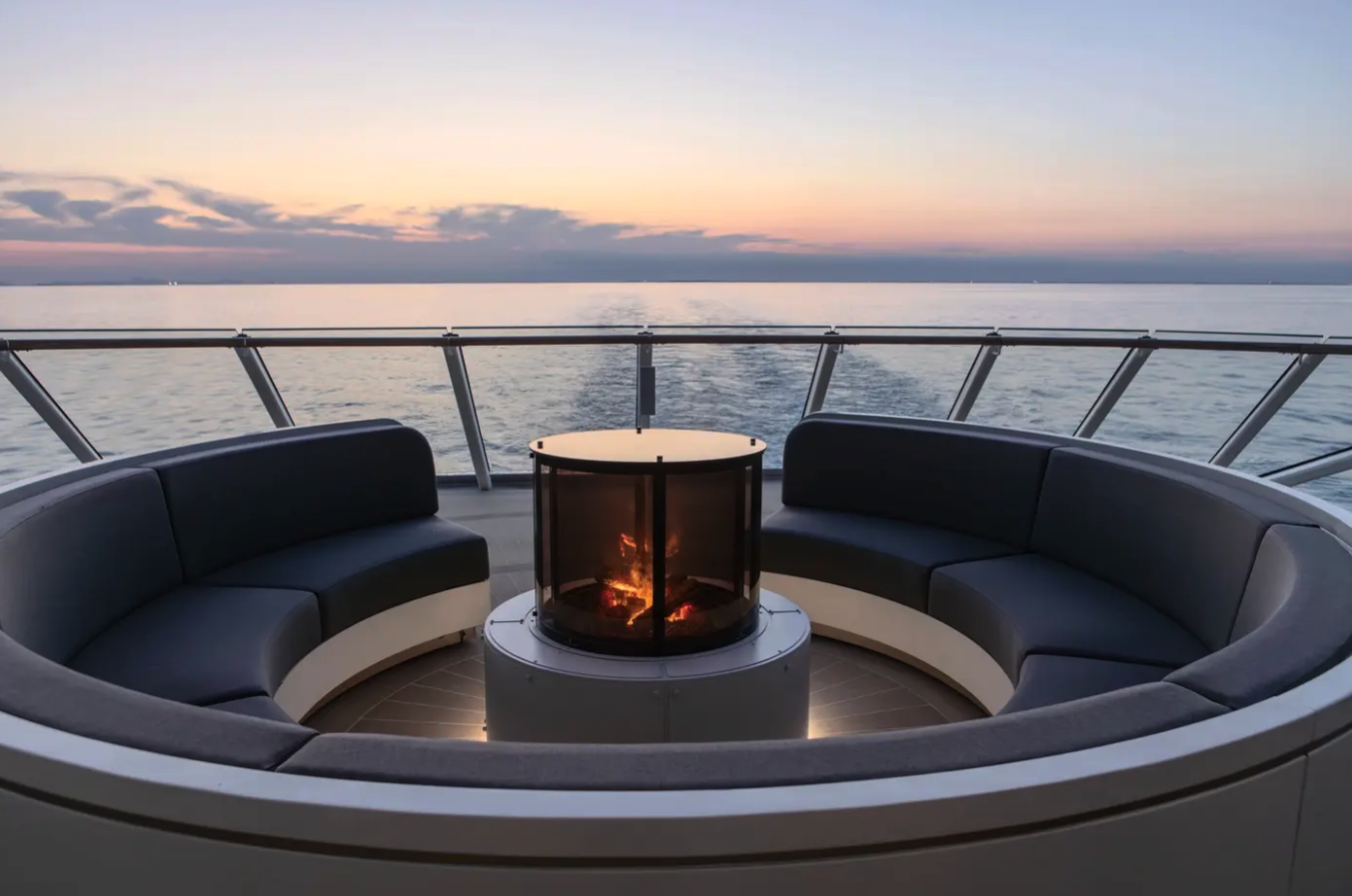
From early morning to late at night, the Panorama lounge offers everything you could wish for. A peaceful retreat that is the perfect place to break away to, a social place to meet and greet old friends, or an evening venue to partake in a cocktail as you sit back and watch the world go by. Sink into the plush seats and come evening, enjoy listening to the gentle sounds of a pianist, or the invigorating beats of our in-house DJ.
Images are intended as a general reference. Features, materials, finishes and layout may be different than shown.
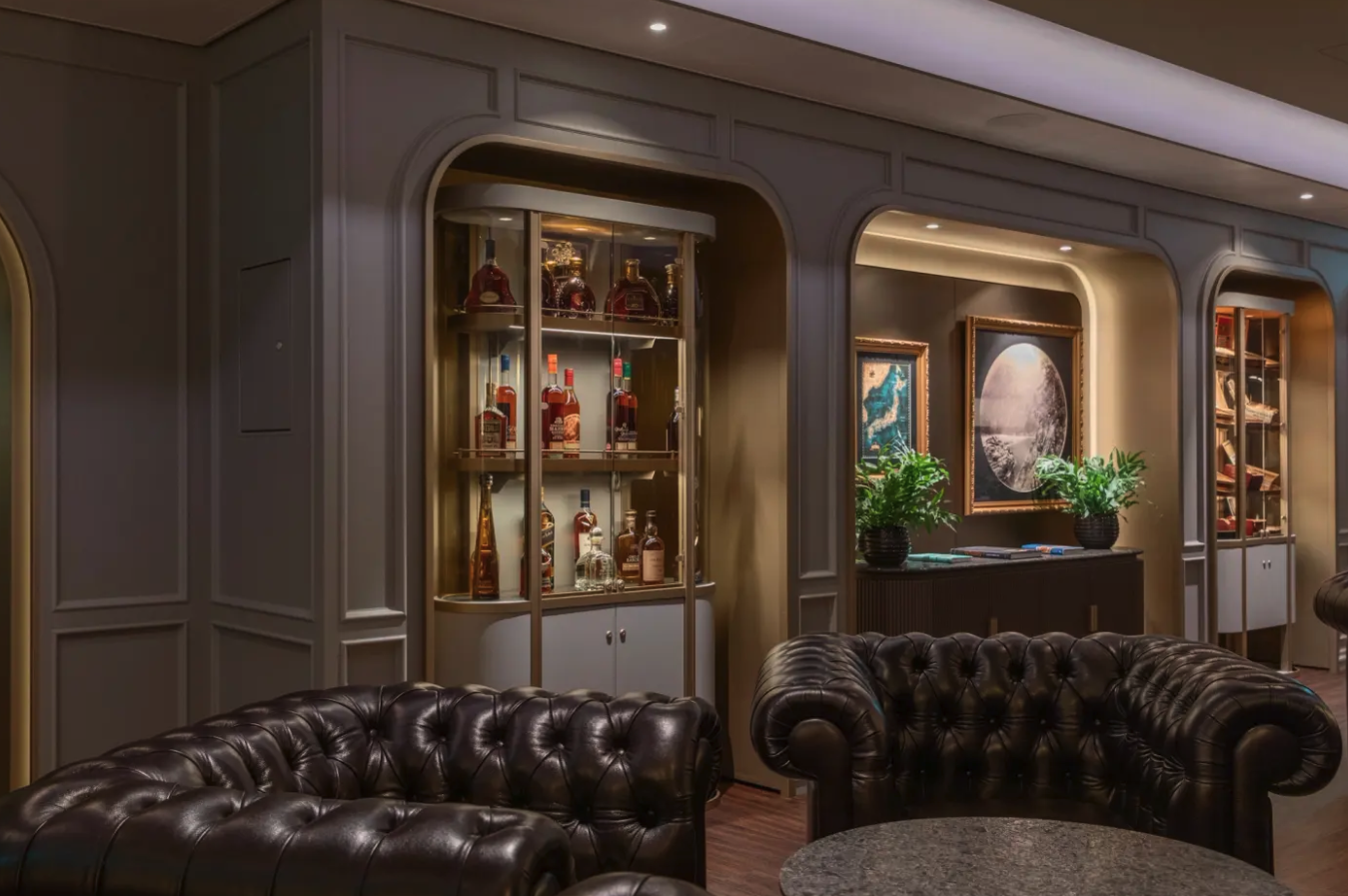
Our smoking lounge aboard Silver Nova is our latest venue where cigar-lovers can buy and sample some of the world’s finest Havanas, Cohibas, Partagás, Montecristos, Ramón Allones and Bolívars. Combining all the elements of cigar culture both indoors and on its stylish terrace, the Connoisseur’s Corner is where aficionados can meet and mingle to share their iconic passion.
Images are intended as a general reference. Features, materials, finishes and layout may be different than shown.
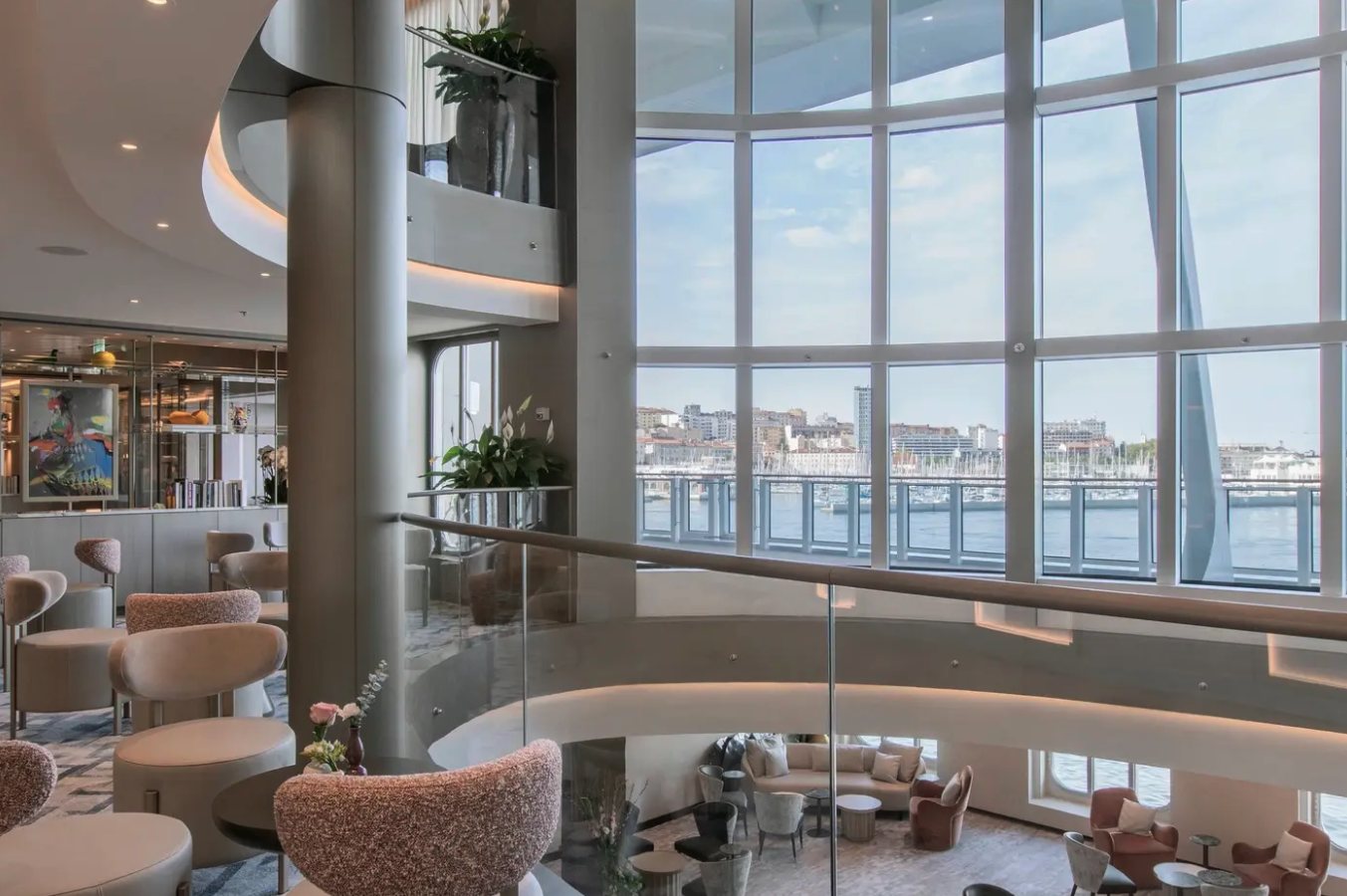
Located on deck 4, the Atrium is the beating heart of Silver Nova. Inspired by Roman architecture, The Atrium magnificent windows floods our central meeting areas with abundant natural light. The area is home to both the Arts Café and The Shelter, as well as main service areas such as the Reception, Shore Concierge and Future Cruise Sales. The Atrium’s enormous glass wall stretches over two decks, guaranteeing a deep connection with your destination whether at sea or docked in port.
Images are intended as a general reference. Features, materials, finishes and layout may be different than shown.

Set on the highest level at the very top of the ship, this is a quiet space for reading and reflection while being dazzled by the undulating seascapes that are constituent to life on board. Borrow a book from the in-house library, read the papers or just embrace the tranquillity of being at sea.
Images are intended as a general reference. Features, materials, finishes and layout may be different than shown.
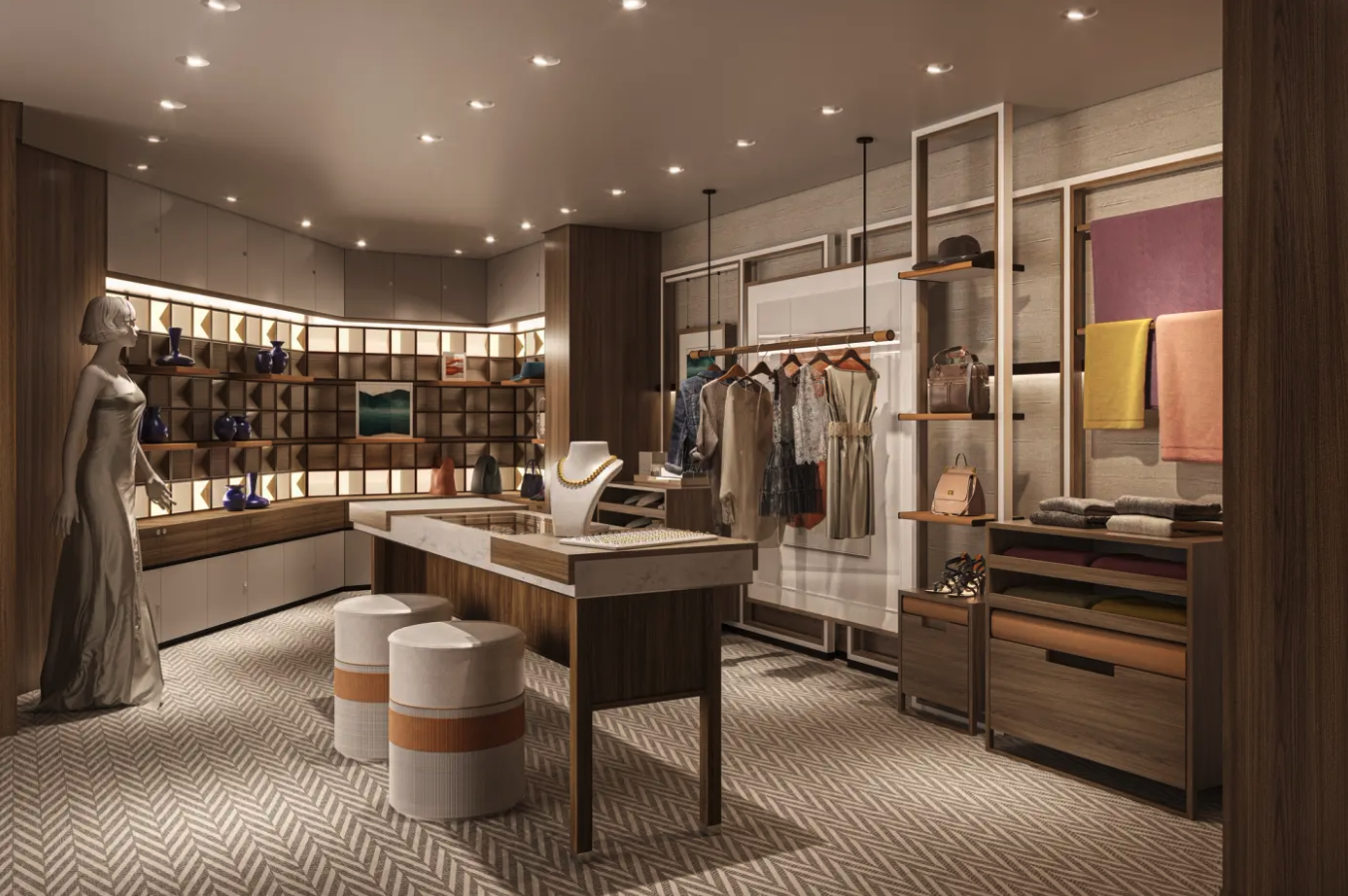
Exceptional shopping experiences do not end in the cosmopolitan cities we visit. Silversea’s striking new shipboard boutiques, reimagined and redesigned are stunning modern design spaces befitting the finest creations from legendary designers. Carefully selected partners onboard Silversea’s duty-free boutiques offers our guests a carefully curated selection of cutting edge fashions, jewellery, accessories, fine perfumes, cosmetics and Silversea Logo collection all at duty-free prices.
Images are intended as a general reference. Features, materials, finishes and layout may be different than shown.
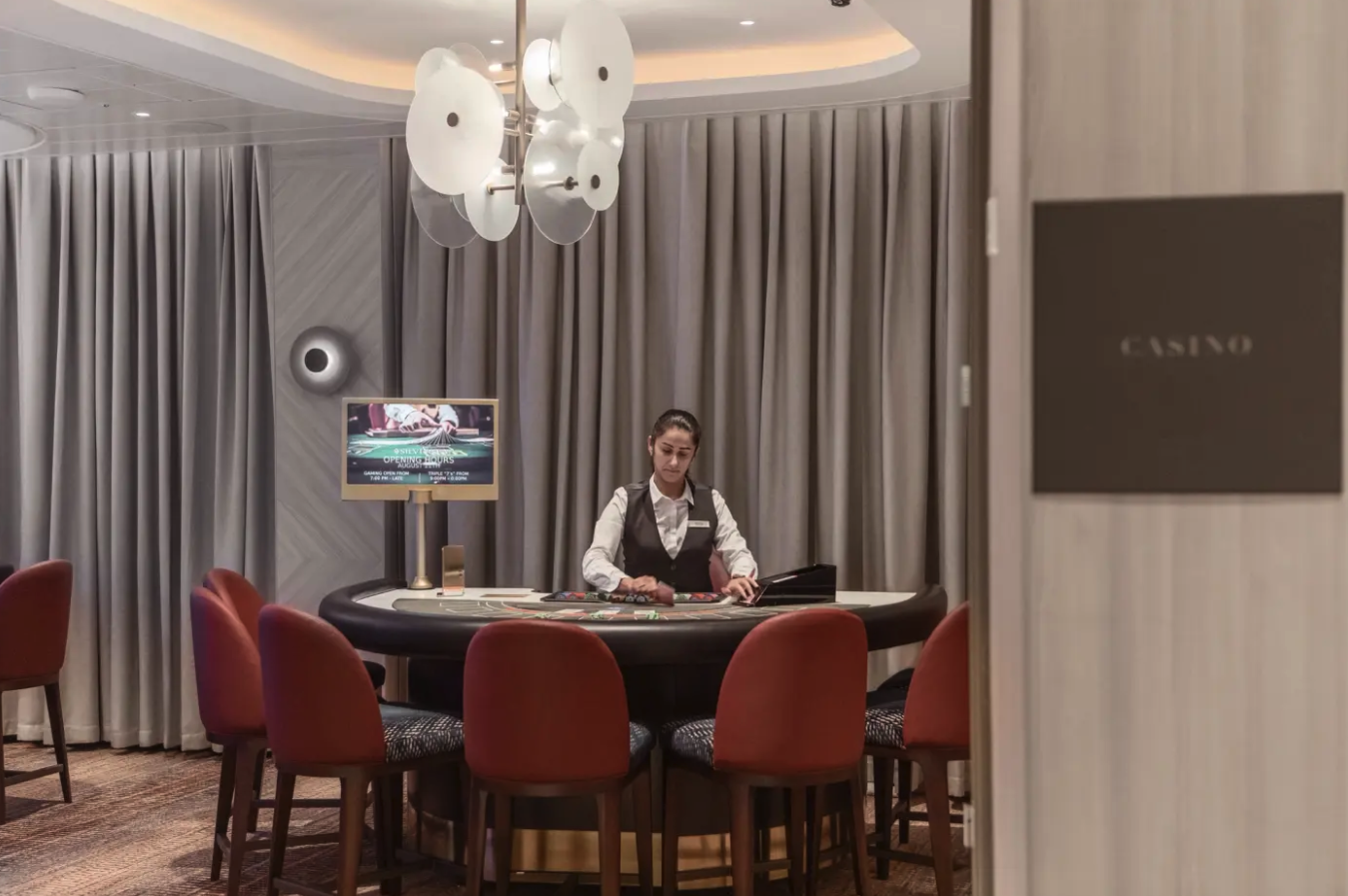
Let the fun begin! Channel your inner James Bond and enjoy a flutter at a variety of table games including American Roulette, Blackjack and Poker as Silver Nova glides silently through the waves. An assortment of multi-game, multi-denominational reel and video slot machines are also available. Prepare yourself for a luxurious and exhilarating experience with every turn of a card and spin of the wheel. Game on!
Images are intended as a general reference. Features, materials, finishes and layout may be different than shown.

The grandeur and magic of music and theatre. The experience of being transported by performance. That satisfying feeling of seeing an evening show … Welcome to Venetian Lounge, a place where the arts of theatre and music meet with full-scale productions and feature films. Paying tribute to a golden age of glamour, Venetian Lounge offers belle-époque style cabaret seating, with intimate tables and chairs subtly placed between the rows of comfortable tiered banquettes. As the stage lights are dimmed, soak up the atmosphere, relax and enjoy a night of dazzling sights and sounds.
Images are intended as a general reference. Features, materials, finishes and layout may be different than shown.

Finding relaxation is one the of the principle aims of taking a cruise, so why not join us in the Otium Spa for guaranteed indulgence? Turn off your phone, slip on your robe and get ready for a bit of me time. Whether you need to unwind with a massage, perk up your skin with a facial or work up a sweat in sauna and steam room, Otium Spa offers the very latest in beauty therapy. Make every day a special occasion in Otium Spa.
Images are intended as a general reference. Features, materials, finishes and layout may be different than shown.

With state of the art Technogym® equipment, free weights and speciality classes, the Fitness Centre brings together elite design with programs that are specifically created for your body type and needs. With personal trainers available for individual sessions, training here is more a five-star experience for all levels of fitness and experience. And with the best view that you’ll ever get whilst working out, there are definitely no more excuses
Personal Trainers
With personal trainers available for individual sessions, training at sea is a five-star experience for all fitness levels. And with the best view you’ll ever get whilst working out, there are definitely no more excuses not to keep fit on board. Personalised training, body composition analysis and speciality classes are available for an additional charge.
Images are intended as a general reference. Features, materials, finishes and layout may be different than shown.
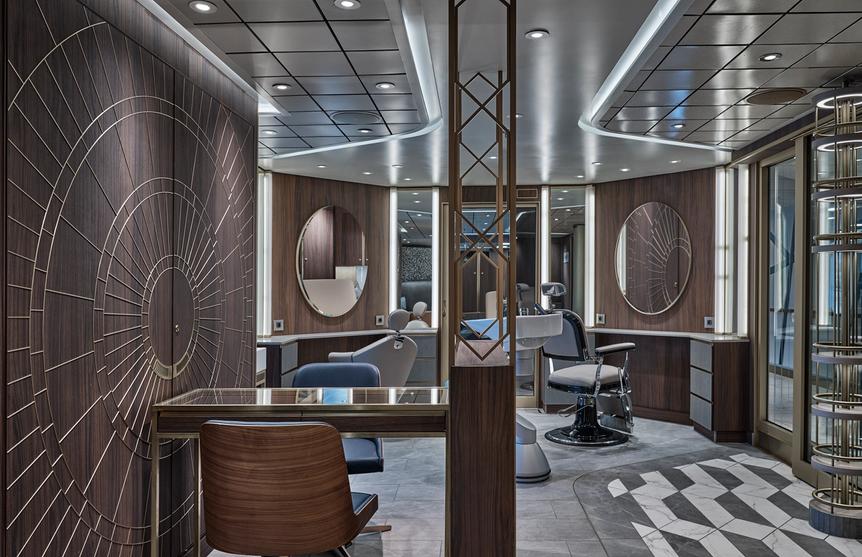
Hair and scalp conditioning treatments, colour protection and hair smoothing are just some of the highly effective salon services available onboard to help you. Our beauty therapists will look after you with manicures, pedicures, complete nail services, and professional teeth whitening. Gentlemen will not feel left out either with our luxurious shave and men’s grooming services.
At Silversea, the comfort, enjoyment and safety of all guests is paramount. To ensure a pleasant and safe environment, smoking is prohibited in most public areas, guest suites or suite balconies. However, cigarette, e-cigarette, cigar, pipe and vaporizer smoking is permitted in the Connoisseur’s Corner both indoors and outdoors (where applicable). In addition, cigarette, e-cigarette and vaporizer smoking is permitted in specifically designated outside areas and tables:
- Silver Nova, Silver Ray: Dusk Bar (port side);
- Silver Muse, Silver Spirit: Panorama Lounge (port side) and Pool Grill (port side);
- Silver Moon, Silver Dawn: Panorama Lounge (starboard side) and Pool Grill (port side);
- Silver Shadow, Silver Whisper: Panorama Lounge (starboard side) and Pool Grill (starboard side);
- Silver Cloud, Silver Wind: Panorama Lounge (port side) and Pool Grill (port side);
- Silver Origin: on open deck 4 aft;
Silversea kindly requests that all guests observe the non-smoking areas.
Each Silversea ship is equipped with a Medical Centre, which is staffed by a doctor and nurse on 24-hour call when at sea. When docked, supplementary emergency care may also be obtained through local medical facilities. Guests may be charged for medical services and for medications used for their medical treatment. The Medical Centre is not intended or designed to provide on-going treatment of pre-existing conditions or for extended critical care, and Silversea is not responsible for the diagnosis, treatment or services furnished by shipboard medical personnel.
If you have special dietary requirements, Silversea will make every attempt to accommodate your requests. Please advise Silversea of your needs on the Guest Information Form at least 75 days prior to sailing. Notification should be sent to specialservices@silversea.com
Wheelchair guests must bring their own collapsible wheelchair. Please note that not all shore excursions are suitable for guests with impaired mobility. Silversea strongly recommends wheelchair guests travel with someone who is able to assist them both ashore and at sea as Silversea may be unable to offer special assistance. Please note that wheel-on and/or wheel-off access may not be available at some ports-of-call. Silversea reserves the right to deny boarding to any guest who failed to notify Silversea of such requirement at the time of booking.
All guests are required to report in writing to Silversea at the time their reservation is made:
- Any physical or mental condition that may require medical or professional treatment or attention during the voyage
- Any condition that may render the guest unfit for travel, or that may require special care or assistance
- Any condition that may pose a risk or danger to the guest or anyone else on board the ship
- Any condition that may require oxygen for medical reasons
- Any intention or need to use a wheelchair aboard ship.
Complete valet services, including laundry, pressing and wet cleaning, are available at an additional charge and may be arranged through your butler. Laundry service is complimentary for certain suite categories and for those Venetian Society members who have reached certain reward levels. A self-service launderette offers washing machines, dryers, irons and laundry supplies, allowing you to limit the amount of cruise luggage needed, especially for longer voyages.
All Silversea ships are equipped to offer wireless (Wi-Fi) Internet access. You can use your own laptop to surf the Internet and check emails at Wi-Fi locations throughout the ship, or from the comfort and privacy of your suite. Computers, email and Internet access are also available on board at the Internet Café. However, it is important to understand that telecommunication services while at sea are via satellite and significantly different than high-speed connections on land back home. The signal travels in a similar manner to radio waves but at much greater distances. Therefore, onboard Internet access is not guaranteed at all times. Satellite communications are also affected by weather and the ship’s location. In particular, Internet service is extremely sporadic while in the Arctic. Guests aboard expedition cruises to/from Svalbard should be prepared to be out of communication for the duration of their time on board. (Please be assured that Silver Explorer always has emergency communication capabilities.)
Silversea cruise guidelines state that children under the age of 18 must be accompanied, in the same or connecting suite, by a parent or other responsible adult over the age of 21 for the duration of the voyage. If the adult accompanying the minor is not their parent, a parental consent guardianship form must be signed by a parent or legal guardian and received by Silversea prior to sailing. Please contact our Special Services Department at SpecialServices@Silversea.com for a Parental Consent Form. Guests must be 21 years of age or older to purchase or consume alcohol. Silversea reserves the right to refuse to serve anyone who in its sole judgment may be under the influence of alcohol, or for any reason necessary in its judgement to preserve the health and safety of guests and employees.
Silversea cannot accommodate infants less than six months of age and reserves the right to limit the number of children less than three years of age (Silver Explorer, Silver Cloud and Silver Wind cannot accommodate infants under the age of 1 year, Silver Origin cannot accommodate children under the age of 5 years). Parents are required to sign a notarised waiver prior to sailing in order to grant a valid booking for children ages between 6 months and 1 year old. A signed and notarised waiver will be required for all children between these ages. Although Silversea accepts guests over the age of 6 months (over the age of 1 year for Silversea Expeditions), there are no special programmes for children on board our luxury cruise ships, and Silversea does not provide for the care, entertainment or supervision of children. Silversea reserves the right to limit the number of children less than 3 years of age.
Children under the age of 8 years old are only permitted to participate in suitable Silver Shore Excursions / shuttle service if the vehicles are equipped with the correct safety harness and seating equipment. Child harnesses and secure seating cannot be guaranteed. Silversea reserves the right to refuse children under the age of 8 years old on any tour on the basis of safety. Guests may use their own approved safety seat, booster seat or harness provided they are compatible with the local touring vehicle and can properly secure the child.
In addition, the Zodiacs used for Silversea Expeditions are unable to accommodate children younger than 5 years of age. As Silversea does not provide babysitting services, an adult family member will be required to remain on board with their child(ren) during Zodiac excursions.
During the day, casual wear, similar to five-star resort sportswear, is suitable for most activities. It is recommended to wear flat or low-heeled shoes on deck.
After 6 pm, our Evening Dress Code applies; jeans, shorts, sneakers, or flip-flop-type footwear are prohibited in indoor spaces.
TWO EVENING TYPES:
1. Elegant Casual
Ladies may opt for trousers, a blouse, skirt, or casual dress. Gentlemen may wear an open-collar shirt and slacks. A jacket is optional.
2. Formal Optional
Ladies may choose an evening gown or cocktail dress. Gentlemen should wear a tuxedo, dinner jacket, or dark suit with a tie. Adhering to our Elegant Casual dress code is also welcomed, but a jacket is still required for gentlemen when indoors
FORMAL OPTIONAL NIGHTS PER SAILING:
- 7 days or less – No Formal Optional night
- 8 to 14 days – 1 to 2 Formal Optional nights
- 15 days or more – 2 or more Formal Optional nights
Onboard Silver Nova we take care of everything, including the environment.
The ocean ecosystem is our home. It’s also how we reach our stunning destinations. However, it’s as fragile as it is vast/ With Silver Nova, we’re introducing a new way of looking at sailing, at the environment, at the ocean itself. Thanks to her, state-of-the-art technologies, Silver Nova is one of the most sustainable cruise ships ever build: a true reflection of our deep commitment to the oceans, the environment and the communities we find at each of our splendid destinations.
Higher efficiency. Cleaner sailing.
Silver Nova was designed from her backbone to lower her environmental impact as much as possible, starting with the carbon footprint for her construction. Her hull was designed to increase dynamic efficiency and minimise fuel consumption. She also incorporates state-of-the-art technologies to reduce onboard waste, such as the newly-developed Micro Auto Gasification System (M.A.G.S.), resulting in lower incineration emissions, and a Waste Heat Recovery System which allows the ship to reuse waste heat (ie. from the absorption chillers) for even more energy efficiency. Furthermore, she’s equipped with Shore Power, a feature that allows Silver Nova’s main generators to be shut down and the ship plugged into the onshore energy supply where available, cutting emissions while in port.

- The Cliff Whirlpool
- Sun Deck
- Elevator

- Observation Lounge
- S.A.L.T. Lab
- S.A.L.T. Bar
- Pool Deck
- Pool Bar
- Library
- The Marquee
- (The Grill & Spaccanapoli)
- The Dusk Bar
- Jogging Track
- Elevator

- Junior Grand Suite
- Classic Veranda Suite
- Superior Veranda Suite
- Premium Veranda Suite
- Medallion Suite
- Deluxe Veranda Suite
- Master Suite
- Signature Suite
- Premium Medallion Suite
- Elevator

- Class Veranda Suite
- Silver Suite
- Medallion Suite
- Superior Veranda Suite
- Premium Veranda Suite
- Deluxe Veranda Suite
- Owner’s Suite
- Master Suite
- Premium Medallion Suite
- Signature Suite
- Elevator

- Grand Suite
- Classic Veranda Suite
- Medallion Suite
- Silver Suite
- Superior Veranda Suite
- Premium Veranda Suite
- Deluxe Veranda Suite
- Otium Suite
- Premium Medallion Suite
- Master Suite
- Signature Suite
- Elevator

- Junior Grand Suite
- Classic Veranda Suite
- Medallion Suite
- Silver Suite
- Superior Veranda Suite
- Premium Veranda Suite
- Deluxe Veranda Suite
- Signature Suite
- Master Suite
- Otium Suite
- Elevator

- Otium Spa
- Fitness Centre
- Beauty Salon
- Casino
- Boutique
- Dolce Vita
- Silver Note
- Connoisseur’s Corner
- Panorama Lounge
- Elevator

- La Dame
- Venetian Lounge
- Boutique
- Reception
- Arts Café
- Shore Concierge
- Atrium
- Kaiseki
- La Terrazza
- Elevator

- Atlantide
- S.A.L.T. Kitchen
- The Shelter
- Elevator

